By regularly engaging with NCLEX Questions students can stay updated on current evidence-based practices in nursing.
NCLEX Child with Musculoskeletal Health Problems Questions
Child with Musculoskeletal Health Problems NCLEX Practice Questions
Question 1.
The nurse plans the discharge of a newborn diagnosed with torticollis (wry neck). Which action should the nurse take?
(a) Teach the parent the side effects of botulinum toxin.
(b) Coordinate outpatient physical therapy.
(c) Verify the date for corrective surgery.
(d) Demonstrate the use of positioning wedges for sleep.
Answer:
(a) Teach the parent the side effects of botulinum toxin.
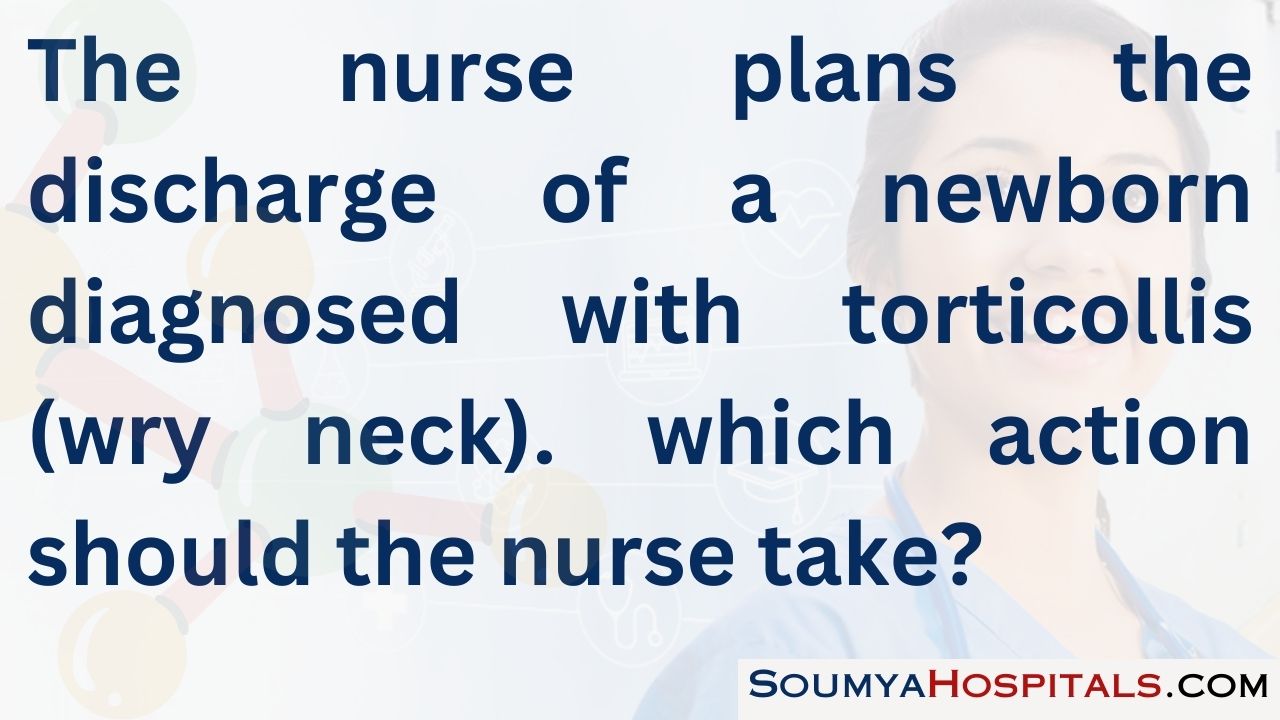
Explanation:
Physical therapy is the most important part of the child’s plan of care. Most cases of torticollis respond to gentle stretching exercises, which the parents perform daily. Regular physical therapy is needed to monitor the infant’s progress.
Botulinum toxin injections are not approved for children under the age of 2 and would not be an appropriate line treatment for an infant. Surgery is only done if physical therapy is not successful after several months. The use of wedges to position children during sleep is not recommended because they increase the risk of SIDS.
Question 2.
A child who limps and has pain has been found to have Legg-Calve-Perthes disease. What should the nurse expect to include in the child’s plan of care?
(a) initiation of pain control measures, especially at night when acute
(b) promotion of ambulation despite child’s discomfort in the affected hip
(c) prevention of flexion in the affected hip and knee
(d) avoidance of weight-bearing on the head of the affected femur
Answer:
(d) avoidance of weight-bearing on the head of the affected femur
Explanation:
Legg-Calve-Perthes disease, also known as coxa plana or osteochondrosis, is characterized by aseptic necrosis at the head of the femur when the blood supply to the area is interrupted. Avoidance of weight-bearing is especially important to prevent the head of the femur from leaving the acetabulum, thus preventing hip dislocation. Devices such as an abduction brace, a leg cast, or a harness sling are used to protect the affected joint while revascularization and bone healing occur.
Surgical procedures are used in some cases. Although pain control measures may be appropriate, pain is not necessarily more acute at night. Initial therapy involves rest and non-weight-bearing to help restore motion. Preventing flexion is not necessary.
Question 3.
When planning home care for the child with Legg-Calve-Perthes disease, what should be the primary focus for family teaching?
(a) need for intake of protein-rich foods
(b) gentle stretching exercises for both legs
(c) management of the corrective appliance
(d) relaxation techniques for pain control
Answer:
(c) management of the corrective appliance
Explanation:
Because most of the child’s care takes place at home, the primary focus of family teaching would be on the care and management of the corrective device. Devices such as an abduction brace, a leg cast, or a harness sling are used to protect the affected joint while revascularization and bone healing occur.
As long as the child is eating a well-balanced diet, there is no need for an intake of protein-rich foods. The parents can encourage range of motion in the unaffected leg, but motion in the affected leg is limited until it heals. Once therapy has been initiated, pain is usually not a problem. The key is management of the corrective device.
Question 4.
At the 2-week well-child visit, a parent states, “My baby seems to keep his head tilted to the right.” Which area should the nurse further assess?
(a) anterior fontanelle
(b) cervical vertebrae
(c) trapezius muscle
(d) sternocleidomastoid muscle
Answer:
(d) sternocleidomastoid muscle
Explanation:
The parent is describing symptoms consistent with torticollis, or wry neck syndrome. With this musculoskeletal disorder, the sternocleidomastoid muscle shortens, causing the infant to drop the head toward the affected muscle and tilt the chin upward in the opposite direction. Frequently, a lump may be felt in the affected muscle. Palpating the fontanelle is done to assess neurologic status, not musculoskeletal status. Torticollis does not involve the cervical vertebrae or trapezius muscle.
Question 5.
An adolescent tells the nurse that the area below his knee has been hurting for several weeks. The nurse should obtain history information about participation in which sport?
(a) soccer
(b) golf
(c) diving
(d) swimming
Answer:
(a) soccer
Explanation:
The adolescent's problem should alert the nurse to the possibility of Osgood-Schlatter disease. This disease, found primarily in boys 10 to 15 years of age and in girls 8 to 13 years of age, occurs when the infrapatellar ligament of the quadriceps muscle
is not well anchored to the tibial tubercle. Excessive activity of the quadriceps muscle results in microtrauma, which causes swelling and pain. Track, soccer, and football commonly produce this condition. Osgood-Schlatter disease is self-limited and usually responds to rest and application of ice.
Question 6.
An adolescent is on the football team and practices in the morning and afternoon before school starts for the year. The temperature on the field has been high. The school nurse has been called to the practice field because the adolescent is now reporting that he has muscle cramps, nau-sea, and dizziness. Which action should the school nurse do first?
(a) Administer cold water with ice cubes.
(b) Take the adolescent’s temperature.
(c) Have the adolescent lie supine.
(d) Move the adolescent to a cool environment.
Answer:
(d) Move the adolescent to a cool environment.
Explanation:
The adolescent is most likely experiencing heat exhaustion or heat collapse, which are common after vigorous exercise in a hot environment. Symptoms result from loss of fluids and include nausea, vomiting, dizziness, headache, and thirst. Treatment consists of moving the adolescent to a cool environment and giving cool liquids. Cool liquids are easier to drink than are cold liquids.
Taking the adolescent’s temperature would be appropriate once these actions have been completed. However, the adolescent’s temperature is likely to be normal or only mildly elevated. Lying in the supine position increases the risk for aspiration if vomiting occurs in a client with nausea.
Question 7.
During a developmental screening, the nurse finds that a toddler child with cerebral palsy has arrested social and language development. What should the nurse tell the family?
(a) “This is a sign the cerebral palsy is progressing.”
(b) “Your child has reached his maximum language abilities.”
(c) “I need to refer you for more developmental testing.”
(d) “We need to modify your therapy plan.”
Answer:
(c) “I need to refer you for more developmental testing.”
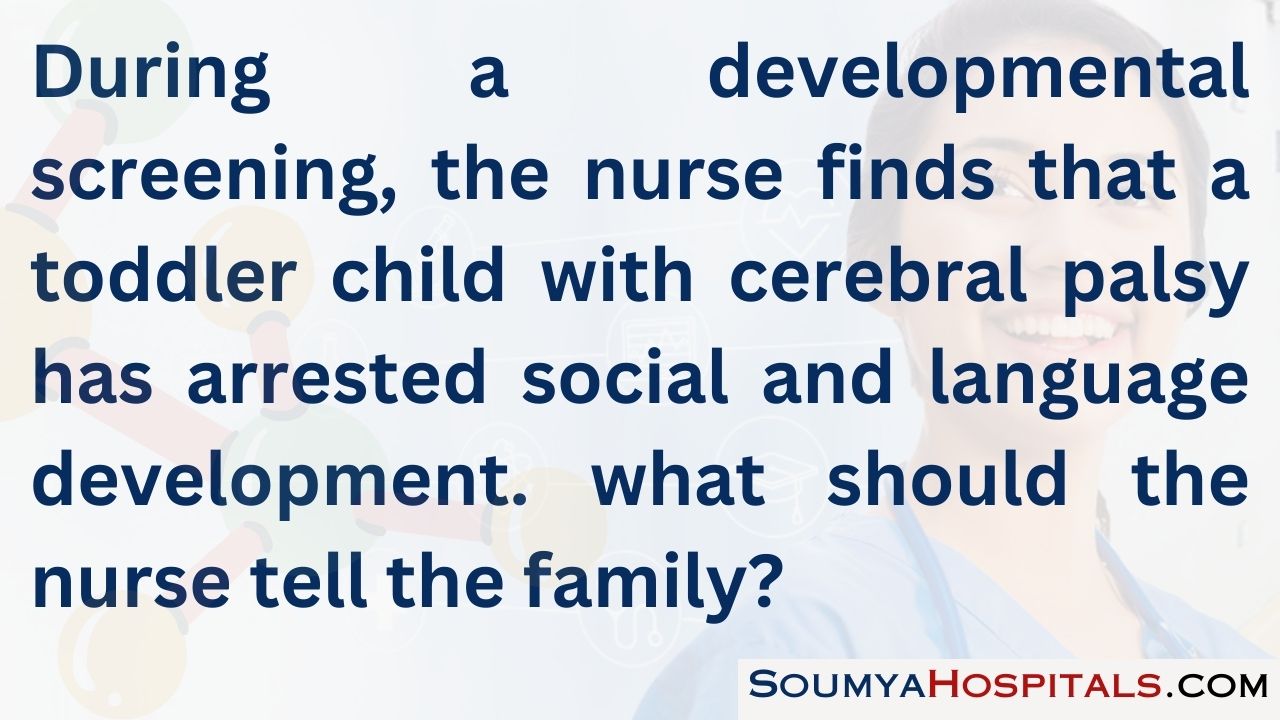
Explanation:
It is important to identify primary developmental delays in children with cerebral palsy and to prevent secondary and tertiary delays. The arrested development is worrisome and requires further investigation. It is possible the lack of development indicates hearing loss or may be a sign of autism. The brain damage caused by cerebral palsy is not progressive.
The brain of a young child is quite plastic; assuming that the child’s development has peaked at age 3 would be a serious mistake. The therapy plan will need to be modified, but a better understanding of the underlying problem will lead to the greatest chance of creating a successful therapy plan.
Question 8.
A child with spastic cerebral palsy is to begin botulinum toxin type A injections. Which treatment goals should the health care team set for the child related to botulinum toxin? Select all that apply.
(a) improved nutritional status
(b) decreased pain from spasticity
(c) improved motor function
(d) enhanced self-esteem
(e) reduced caregiver strain
(f) decreased speech impediments
Answer:
(b) decreased pain from spasticity
(c) improved motor function
(d) enhanced self-esteem
(e) reduced caregiver strain
Explanation:
(b), (c), (d), (e) Botulinum toxin injections can be used to improve many aspects of quality of life for the child with cerebral palsy. The injections can help decrease pain from spasticity. Injections improve motor status by reducing rigidity and allowing for more effective physical therapy to improve range of motion. Decreased spasms enhance self-esteem. Improved motor status facilitates the ability to provide some aspects of care, especially transfers. Botulinum does not significantly affect nutritional status or speech.
Question 9.
The nurse assesses a parent’s understanding of cerebral palsy. The nurse determines that the parent has an accurate understanding of cerebral palsy when she describes it as a term applied to impaired movement resulting from which factor?
(a) injury to the cerebrum caused by viral infection
(b) malformed blood vessels in the ventricles caused by inheritance
(c) nonprogressive brain damage caused by injury
(d) inflammatory brain disease caused by metabolic imbalances
Answer:
(c) nonprogressive brain damage caused by injury
Explanation:
The term cerebral palsy (CP] refers to a group of nonprogressive disorders of upper motor neuron impairment that result in motor dysfunction due to injury. In addition, a child may have speech or ocular difficulties, seizures, hyperactivity, or cognitive impairment. The condition of congenital malformed blood vessels in the ventricles is known as arteriovenous malformations. Viral infection and metabolic imbalances do not cause CP.
Question 10.
The nurse conducts a developmental screening of a 15-month-old child with cerebral palsy. Which milestones would the nurse expect a typically developing toddler of this age to have achieved?
(a) walking up steps
(b) using a spoon
(c) copying a circle
(d) putting a block in a cup
Answer:
(d) putting a block in a cup
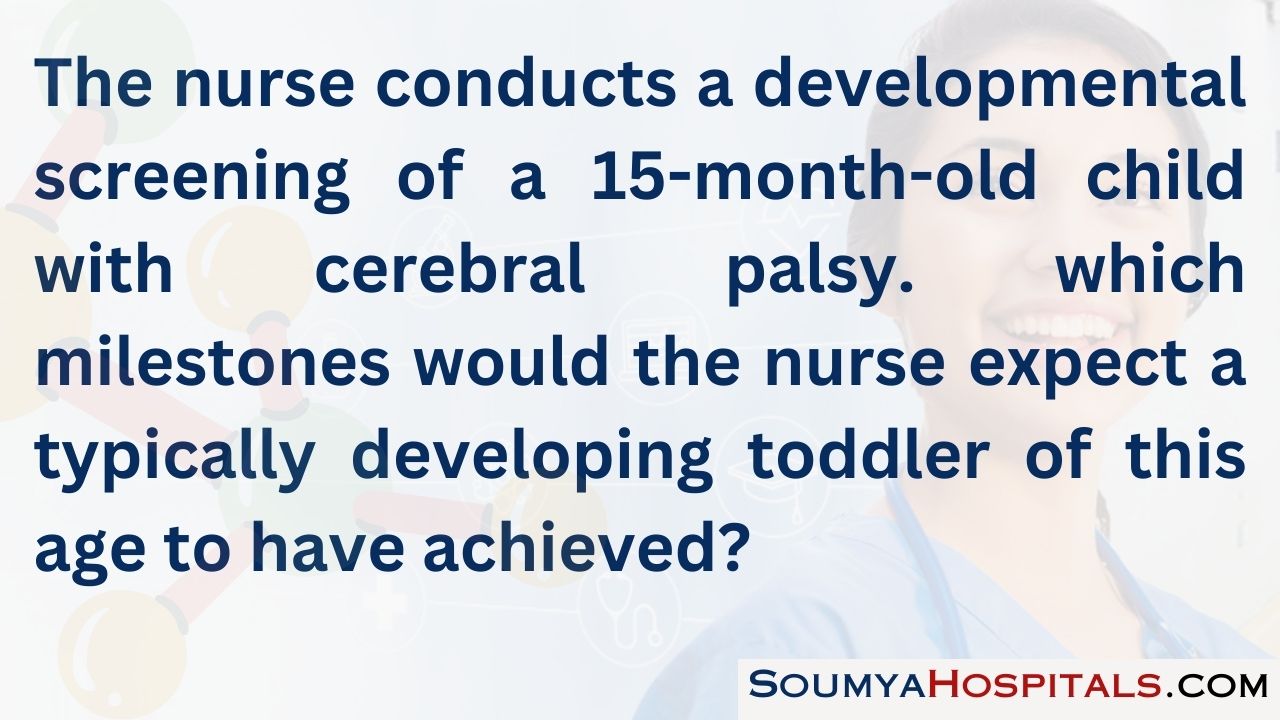
Explanation:
Delay in achieving developmental milestones is a characteristic of children with cerebral palsy. Ninety percent of typically developing 15-month-old children can put a block in a cup. Walking up steps typically is accomplished at 18 to 24 months. A child usually is able to use a spoon at 18 months. The ability to copy a circle is achieved at approximately 3 to 4 years of age.
Question 11.
The parent of a child with spastic cerebral palsy and a communication disorder tells the nurse, “He seems so restless. I think he is in pain.” Which action is most indicated?
(a) Assess the child for pain using the faces, legs, activity, cry, and consolability (FLACC) scale.
(b) Assess the child for pain using the pediatric FACES scale.
(c) Administer prescribed pain medication.
(d) Notify the health care provider (HCP) of the change in behavior.
Answer:
(c) Administer prescribed pain medication.
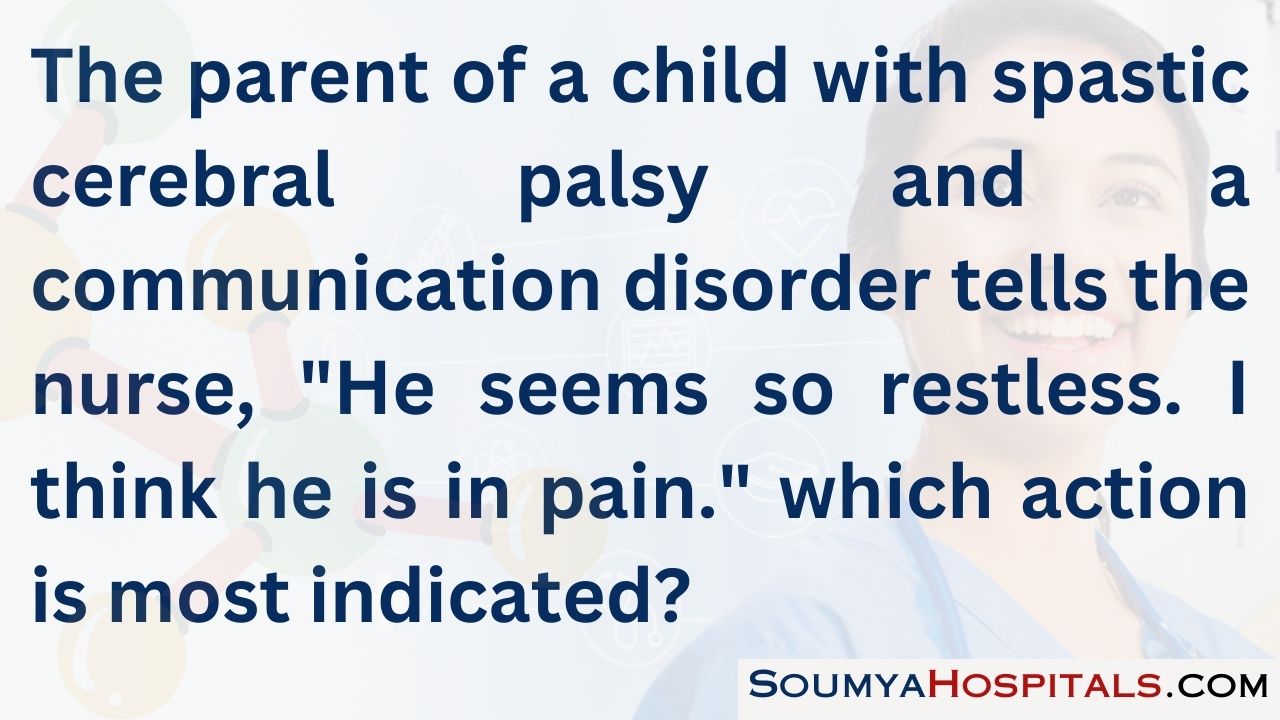
Explanation:
The parent is the child’s HCP and may be very in tune to subtle changes in the child’s behavior. If the parent thinks the child is in pain, it is very likely to be so. The nurse should administer the pain medication and evaluate if the medication affected the child’s behavior. The FLACC scale may be difficult to interpret when the child has spasticity. The FACES scale requires self-reporting, which may not be possible in a child with a communication disorder. The HCP should be contacted regarding the change in behavior only if other available interventions are unsuccessful.
Question 12.
The parent asks the nurse whether a child with hemiparesis due to spastic cerebral palsy will be able to walk normally because he can pull himself to a standing position. Which response by the nurse would be most appropriate?
(a) “Ask your health care provider what he or she thinks at your next appointment.”
(b) “Being able to pull to a stand really only tells us his upper-body strength is good.”
(c) “It is difficult to predict, but his ability to bear weight is a positive factor.”
(d) “If he really wants to walk, and works hard, he probably will eventually.”
Answer:
(c) “It is difficult to predict, but his ability to bear weight is a positive factor.”
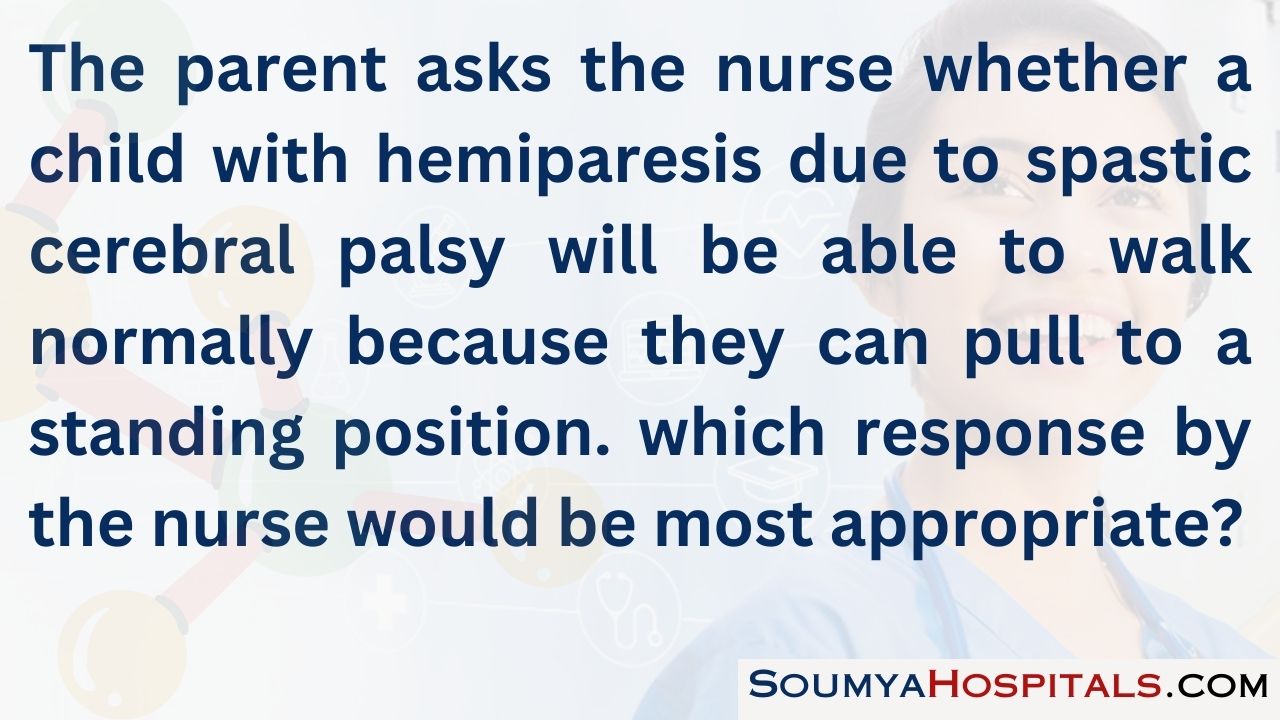
Explanation:
The nurse needs to respond honestly to the mother. Most children with hemiparesis due to spastic cerebral palsy are able to walk because the motor deficit is usually greater in the upper extremity. There is no need to refer the mother to the HCP im. Pulling to a stand requires both upper body and lower body strength. The will to walk
is important, but without neurologic stability, the child may be unable to do so.
Question 13.
The nurse assesses the family’s ability to cope with the child’s cerebral palsy. Which action should alert the nurse to the possibility of their inability to cope with the disease?
(a) limiting interaction with extended family and friends
(b) learning measures to meet the child’s physical needs
(c) requesting teaching about cerebral palsy in general
(d) seeking advice on coping on social media
Answer:
(a) limiting interaction with extended family and friends
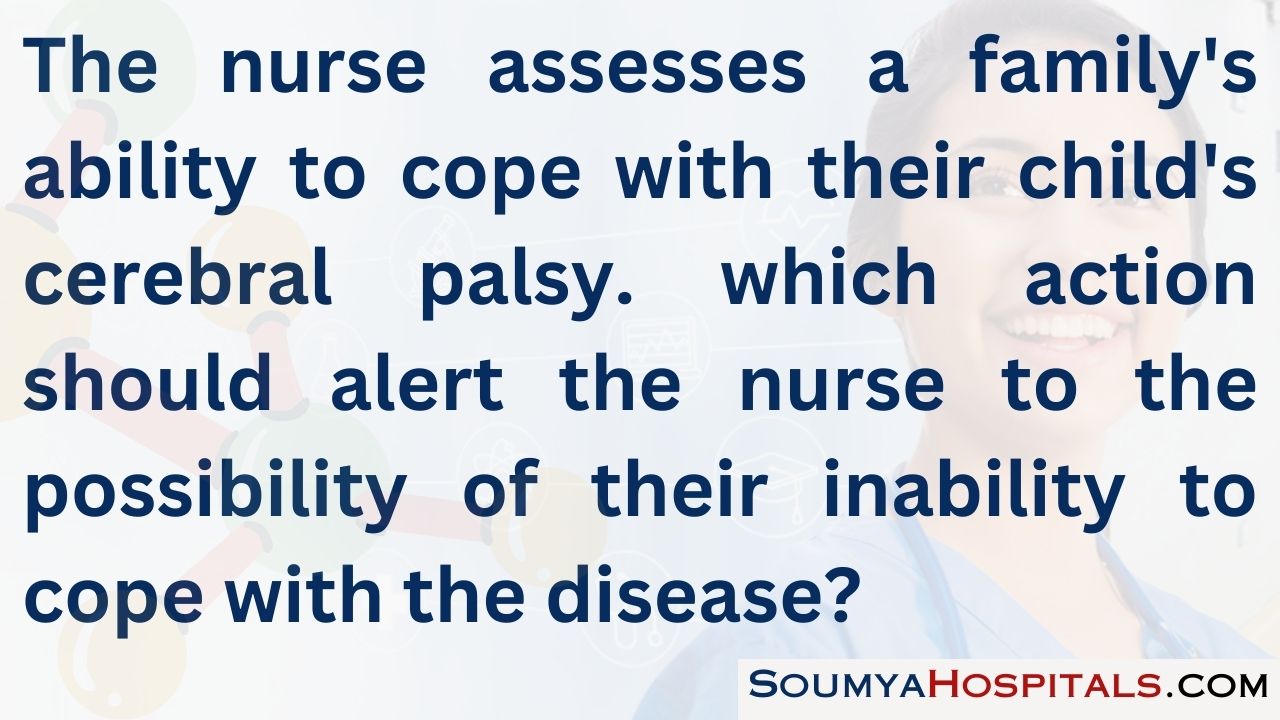
Explanation:
Limited interaction or lack of interaction with friends and family may lead the nurse to suspect a possible problem with the family’s ability to cope with others’ reactions and responses to a child with cerebral palsy. Learning measures to meet the child’s physical needs demonstrates some understanding and acceptance of the disease.
Requesting teaching about the disease suggests curiosity or a desire for understanding, thus demonstrating that the family is dealing with the situation. Participating in social media may serve as a form of support and can be a healthy coping mechanism.
Question 14.
The parent of a child with Duchenne’s muscular dystrophy asks about the chance that the next child will have the disease. What should the nurse tell the parent?
(a) “Sons have a 50% chance of being affected.”
(b) “Daughters have a 1 in 4 chance of being carriers.”
(c) “Each child has a 1 in 4 chance of developing the disease.”
(d) “Each child has a 50% chance of being a carrier.”
Answer:
(a) “Sons have a 50% chance of being affected.”
Explanation:
Duchenne’s muscular dystrophy is an X-linked recessive disorder. The gene is transmitted through female carriers to affected sons 50% of the time. Daughters have a 50% chance of being carriers.
Question 15.
A nurse is making an initial visit to a family with a preschool child with early Duchenne’s muscular dystrophy. Which assessment is an expected finding in this child?
(a) contractures of the large joints
(b) enlarged calf muscles
(c) difficulty riding a tricycle
(d) atrophied muscles
Answer:
(c) difficulty riding a tricycle
Explanation:
Usually, the first clinical manifestations of Duchenne’s muscular dystrophy include difficulty with typical age-appropriate physical activities such as running, riding a tricycle, and climbing stairs. Contractures of the large joints typically occur much later in the disease process. Occasionally, enlarged calves may be noted, but they are not typical findings in a child with Duchenne’s muscular dystrophy. Muscular atrophy and development of small, weak muscles are later signs.
Question 16.
The nurse observes that a child with Duchenne’s muscular dystrophy attempts to rise from a sitting position on the floor. After attaining a kneeling position, the child “walks” his hands up his legs to stand. The nurse documents this as which sign?
(a) Galeazzi’s sign
(b) Goodell’s sign
(c) Goodenough’s sign
(d) Gower’s sign
Answer:
(d) Gower’s sign
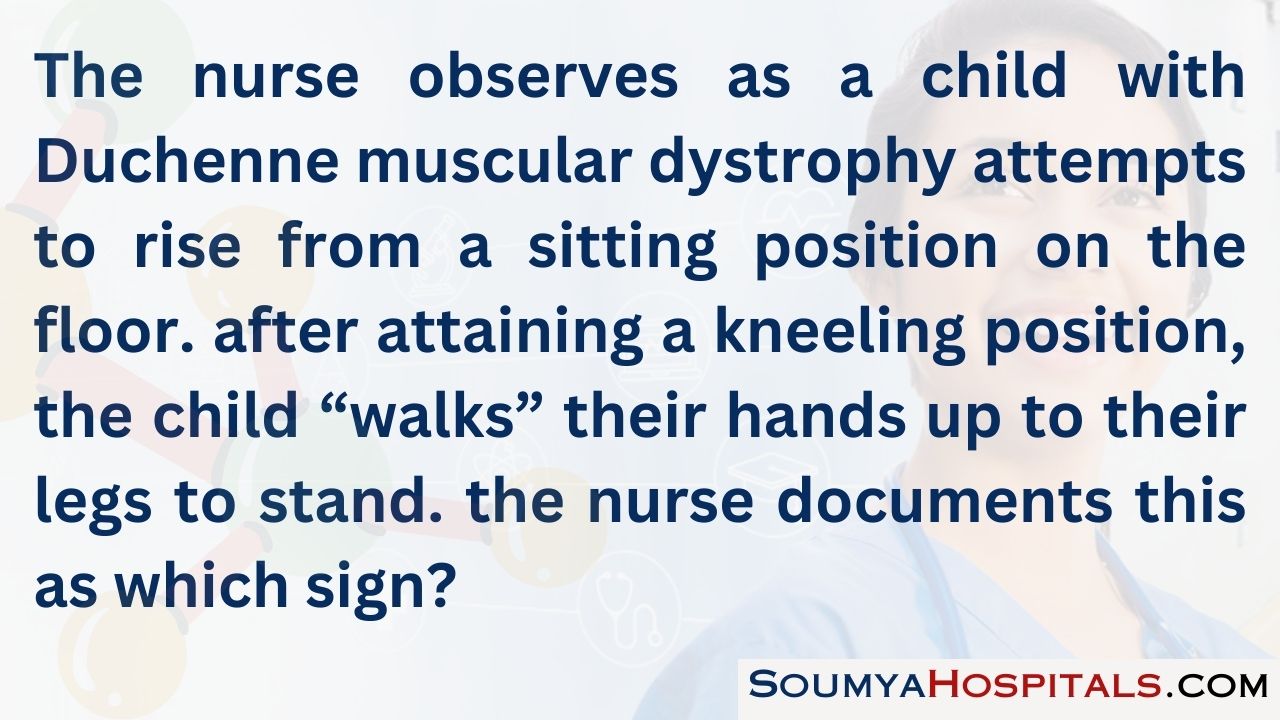
Explanation:
With Gower’s sign, the child walks the hands up the legs in an attempt to stand, a common approach used by children with Duchenne’s muscular dystrophy when rising from a sitting to a standing position. Galeazzi’s sign refers to the shortening of the affected limb in congenital hip dislocation. Goodell’s sign refers to the softening of the cervix, considered a sign of probable pregnancy. Goodenough’s sign refers to a test of mental age.
Question 17.
The nurse develops the plan of care for a child with early Duchenne’s muscular dystrophy. What is the priority goal for this client?
(a) Encourage early wheelchair use.
(b) Foster social interactions.
(c) Maintain the function of unaffected muscles.
(d) Prevent circulatory impairment.
Answer:
(c) Maintain the function of unaffected muscles.
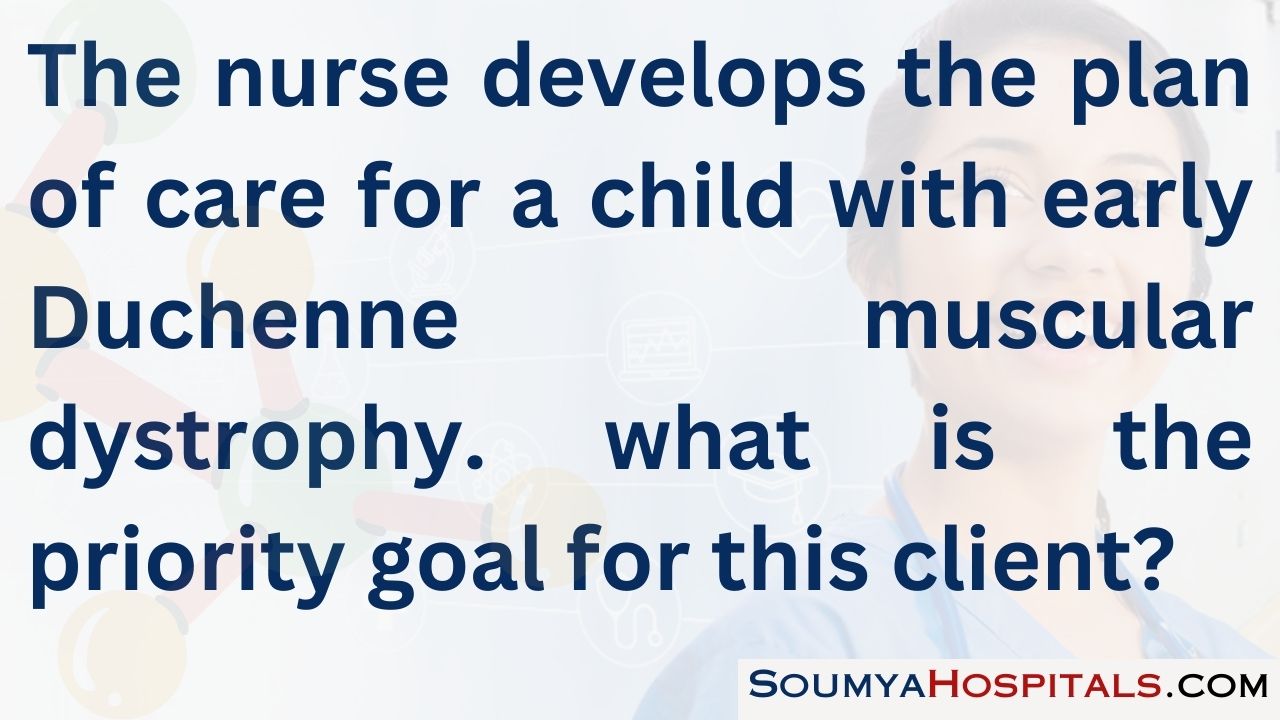
Explanation:
The primary nursing goal is to maintain function in unaffected muscles for as long as possible. There is no effective treatment for childhood muscular dystrophy. Children who remain active are able to forestall being confined in a wheelchair. Remaining active also minimizes the risk of social isolation. Preventing rather than encouraging wheelchair use by maintaining function for as long as possible is an appropriate nursing goal.
Children with muscular dystrophy become socially isolated as their condition deteriorates and they can no longer keep up with friends. Maintaining function helps prevent social isolation. Circulatory impairment is not associated with muscular dystrophy.
Question 18.
When interacting with the parent of a child who has Duchenne’s muscular dystrophy, the nurse observes behavior indicating that the parent may feel guilty about the child’s condition. The nurse interprets this behavior as guilt stemming from which factor?
(a) the terminal nature of the disease
(b) the dependent behavior of the child
(c) the genetic mode of transmission
(d) the sudden onset of the disease
Answer:
(c) the genetic mode of transmission
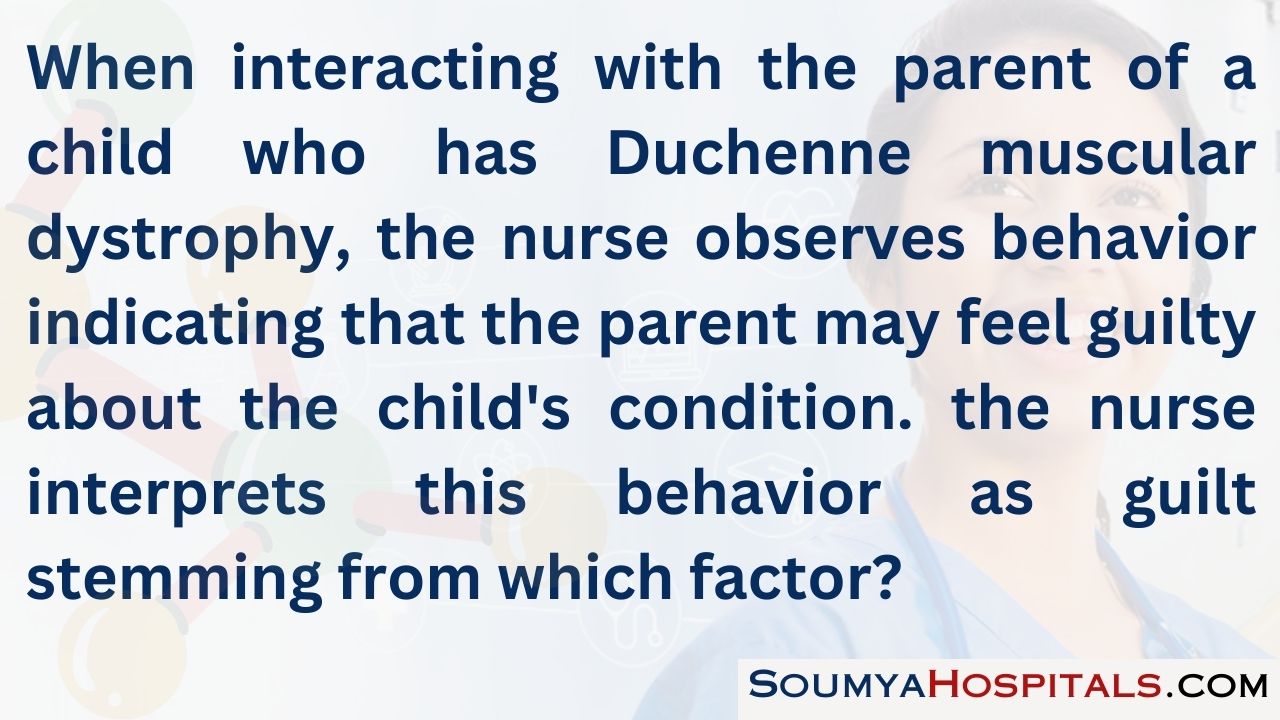
Explanation:
The guilt that mothers of children with muscular dystrophy commonly experience usually results from the fact that the disease is genetic and the mother transmits the defective gene. Although many children die from the disease, the disease is considered chronic and progressive. As the disease progresses, the child becomes more dependent. However, guilt typically stems from the knowledge that the mother transmitted the disease to her son rather than the dependency of the child. The disease onset is usually gradual, not sudden.
Question 19.
The nurse teaches the parent of a young child with Duchenne’s muscular dystrophy about the disease and its management. Which statement by the parent indicates successful teaching?
(a) “My son will probably be unable to walk independently by the time he is 9 to 11 years old.”
(b) “Muscle relaxants are effective for some children; I hope they can help my son.”
(c) “When my son is a little older, he can have surgery to improve his ability to walk. ”
(d) “I need to help my son be as active as possible to prevent the progression of the disease.”
Answer:
(a) “My son will probably be unable to walk independently by the time he is 9 to 11 years old.”
Explanation:
Muscular dystrophy is a progressive disease. Children who are affected by this disease usually are unable to walk independently by age 9 to 11 years. There is no effective treatment for childhood muscular dystrophy. Although children who remain active are able to avoid wheelchair confinement for a longer period, activity does not prevent disease progression.
Question 20.
A 16-month-old child is seen in the clinic for a checkup for the first time. The nurse notices that the toddler limps when walking. Which would be appropriate to use when assessing this toddler for developmental dysplasia of the hip?
(a) Ortolani’s maneuver
(b) Barlow’s maneuver
(c) Adam’s position
(d) Trendelenburg’s sign
Answer:
(d) Trendelenburg’s sign
Explanation:
A Trendelenburg’s sign is seen in children with developmental dysplasia of the hip who are walking. Weight-bearing causes the pelvis to tilt downward on the unaffected side instead of upward as it would normally. Ortolani’s maneuver is used during the neonatal period to assess developmental dysplasia of the hip in infants. With the infant quiet, relaxed, and lying on the back, the hips and knees are flexed at right angles.
The knees are moved to abduction, and pressure is exerted. If the femoral head moves forward, then it is dislocated. Barlow’s maneuver is used to assess developmental dysplasia of the hip in infants. As the femur is moved into or out of the acetabulum, a “clunk” is heard, indicating dislocation. Adam’s position is used to evaluate for structural scoliosis. The child bends forward with feet together and arms hanging freely or with palms together.
Question 21.
The nurse is assessing the infant shown in the figure. On observing the client from this angle, the nurse should document that this infant has which finding?
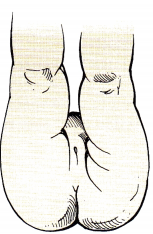
(a) Ortolanis click
(b) limited abduction
(c) Galeazzi’s sign
(d) asymmetric gluteal folds
Answer:
(d) asymmetric gluteal folds
Explanation:
This infant with congenital hip dysplasia has asymmetric gluteal folds. The Ortolani’s “click” occurs when the nurse feels the femur sliding into the acetabulum with a “click.” Limited abduction may be observed during an attempt to abduct the infant’s thighs. Galeazzi’s sign reveals femoral foreshortening and is observed by flexing the thighs
Question 22.
The nurse teaches the parents of an infant with developmental dysplasia of the hip how to handle their child in a Pavlik harness. Which care is most appropriate?
(a) Fit the diaper under the straps.
(b) Leave the harness off while the infant sleeps.
(c) Check for skin redness under straps every other day.
(d) Put powder on the skin under the straps every day.
Answer:
(a) Fit the diaper under the straps.
Explanation:
The Pavlik harness is worn over a diaper. Knee socks are also worn to prevent the straps and foot and leg pieces from rubbing directly on the skin. For maximum results, the infant needs to wear the harness continuously. The skin should be inspected several times a day, not every other day, for signs of redness or irritation. Lotions and powders are to be avoided because they can cake and irritate the skin.

Question 23.
When developing the teaching plan for parents using the Pavlik harness with their child, what should be the nurse’s initial step?
(a) Assess the parents’ current coping strategies.
(b) Determine the parents’ knowledge about the device.
(c) Provide the parents with written instructions.
(d) Give the parents a list of community resources.
Answer:
(b) Determine the parents’ knowledge about the device.
Explanation:
Assessing the learner’s knowledge level is the initial step in any teaching plan to promote the maximum amount of learning. This assessment also provides the nurse with a starting point for teaching. Assessing coping strategies can provide important information to the development of the teaching plan but is not the initial step. Giving parents written instructions or a list of community resources is appropriate once the parents’ knowledge level has been determined and teaching has begun.
Question 24.
When teaching the family of an older infant who has had a spica cast applied for developmental dysplasia of the hip, which information should the nurse include when describing the abduction stabilizer bar?
(a) It can be adjusted to a position of comfort.
(b) It is used to lift the child.
(c) It adds strength to the cast.
(d) It is necessary to turn the child.
Answer:
(c) It adds strength to the cast.
Explanation:
The abduction bar is incorporated into the cast to increase the cast’s strength and maintain the legs in alignment. The bar cannot be removed or adjusted, unless the cast is removed and a new cast is applied. The bar should never be used to lift or turn the client because doing so may weaken the cast.
Question 25.
A parent asks the nurse about using a car seat for a toddler who is in a hip spica cast. What should the nurse tell the parent?
(a) “You can use a seat belt because of the spica cast.”
(b) “You will need a specially designed car seat for your toddler.”
(c) “You can still use the car seat you already have.”
(d) “You will need to get a special release from the police so that a car seat will not be needed.”
Answer:
(b) “You will need a specially designed car seat for your toddler.”
Explanation:
The toddler in a hip spica cast needs a specially designed car seat. The one that the parent already has will not be appropriate because of the need for the car seat to accommodate the cast and abductor bar.
Question 26.
The nurse is discharging a baby with club foot who has had a cast applied. The nurse should provide additional teaching to the parents if they make which statement?
(a) “I should call if I see changes in the color of the toes under the cast.”
(b) “I should use a pillow to elevate my child’s foot as he sleeps.”
(c) “My baby will need a series of casts to fix her foot.”
(d) “Having a cast should not prevent me from holding my baby.”
Answer:
(b) “I should use a pillow to elevate my child’s foot as he sleeps.”
Explanation:
Elevating the extremities at different points during the day is helpful to prevent edema, but pillows should not be used in the crib because they increase the risk of sudden infant death syndrome (SIDS). A change in the color of the toes is a sign of impaired circulation and requires medical evaluation. Children typically need a series of 5 to 10 casts to correct the deformity. Infants with club feet still need frequent holding like any other newborn.
Question 27.
The parents of a neonate born with congenital clubfoot express feelings of helplessness and guilt and are exhibiting anxiety about how the neonate will be treated. Which action by the nurse would be most appropriate initially?
(a) Ask them to share these concerns with the health care provider (HCP).
(b) Arrange a meeting with other parents whose infants have had successful clubfoot treatment.
(c) Discuss the problem with the parents and the current feelings that they are experiencing.
(d) Suggest that they make an appointment to talk things over with a counselor.
Answer:
(c) Discuss the problem with the parents and the current feelings that they are experiencing.
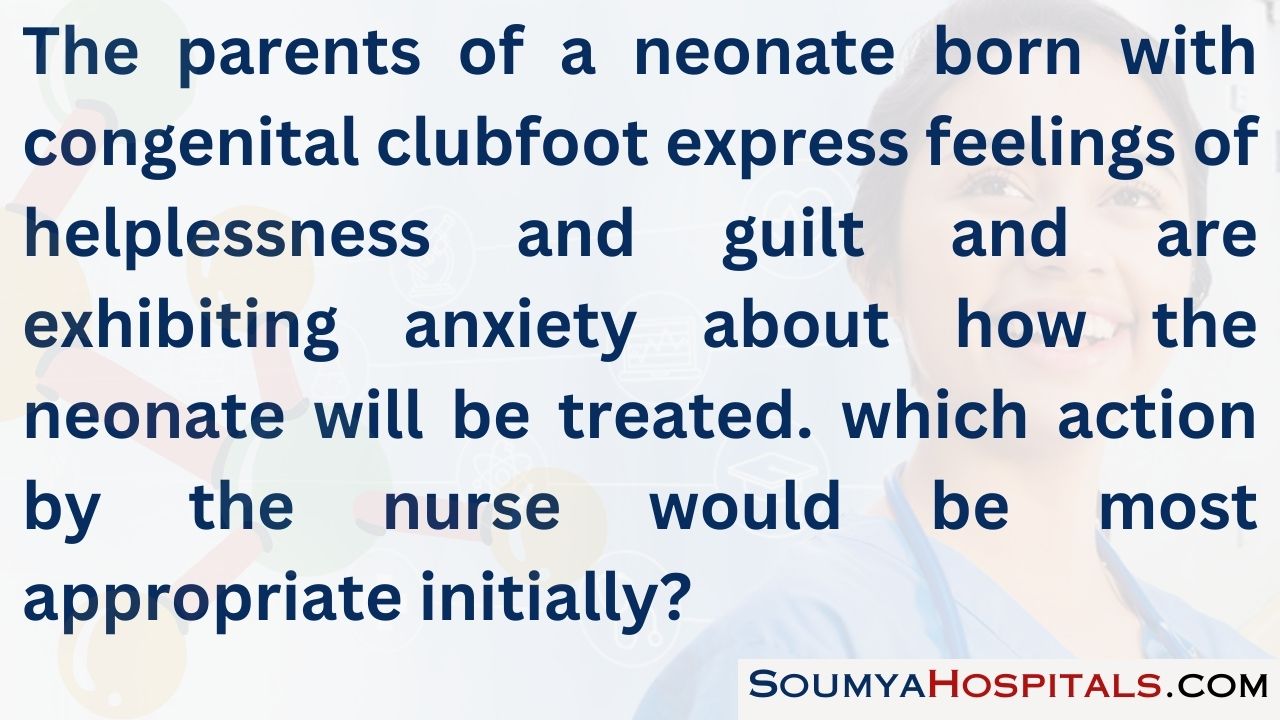
Explanation:
When an infant is born with an unexpected anomaly, parents are faced with questions, uncertainties, and possible disappointments. They may feel inadequate, helpless, and anxious. The nurse can help the parents initially by assessing their concerns and providing appropriate information to help them clarify or resolve the immediate problems. Referring the parents to the health care provider (HCP) is not necessary at this time.
The nurse can assist the parents by listening to their concerns. Having them talk with other parents would be helpful a little bit later, once the nurse assesses their concerns and discusses the problem and the parents’ current feelings. If the parents continue to have difficulties expressing and working through their feelings, a referral to a counselor would be appropriate.
Question 28.
After teaching the parents of an infant with clubfoot requiring the application of a plaster cast and how to care for the cast, which statement would indicate that the parents have understood the teaching?
(a) “If the cast becomes soiled, we will clean it with soap and water.”
(b) “We will elevate the leg with the cast on pillows so the leg is above heart level.”
(c) “We will check the color and temperature of the toes of the casted leg frequently.”
(d) “The petals on the edge of the cast can be removed after the first 24 hours.”
Answer:
(c) “We will check the color and temperature of the toes of the casted leg frequently.”
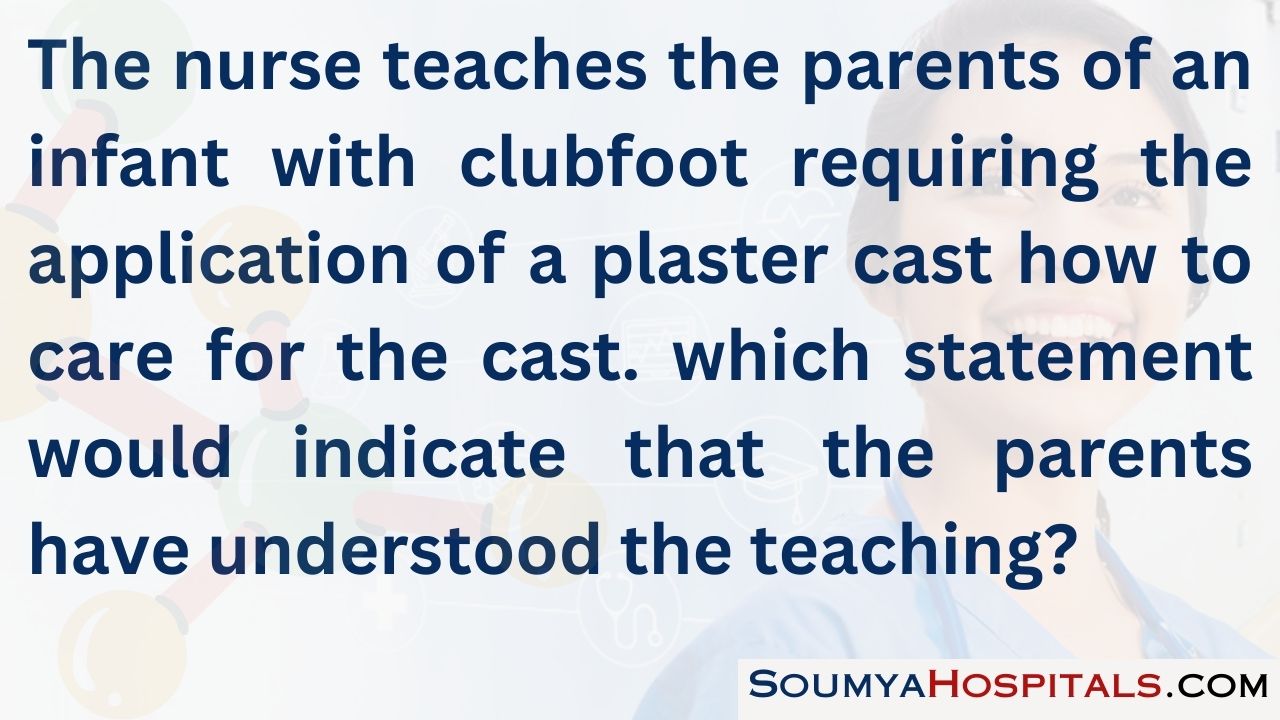
Explanation:
A cast that is too tight can cause a tourniquet effect, compromising the neurovascular integrity of the extremity. Manifestations of neurovascular impairment include pain, edema, pulselessness, coolness, altered sensation, and inability to move the distal exposed extremity. The toes of the casted extremity should be assessed frequently to evaluate for changes in neurovascular integrity.
Wetting a plaster cast with water and soap softens the plaster, which may alter the cast’s effectiveness. There is no reason to elevate the casted extremities when a child with clubfoot is being treated with nonsurgical measures. The legs would be elevated if swelling were present. Petals, which are applied to cover the rough edges of the cast, are to be left in place to minimize the risk of skin irritation from the cast edges.
Question 29.
The parent of a preschool-age child with a tentative diagnosis of juvenile idiopathic arthritis (JIA) asks about a test to definitively diagnose JIA. What should the nurse tell the parent?
(a) “The latex fixation test is diagnostic.”
(b) “An increased erythrocyte sedimentation rate is diagnostic.”
(c) “A positive synovial fluid culture is diagnostic.”
(d) “No specific laboratory test is diagnostic.”
Answer:
(d) “No specific laboratory test is diagnostic.”

Explanation:
The nurse’s response to the father is based on the knowledge that there is no definitive test for JIA. The latex fixation test, which is commonly used to diagnose arthritis in adults, is negative in 90% of children. The erythrocyte sedimentation rate may or may not be increased during active disease. This test identifies the presence of inflammation only. Synovial fluid cultures are done to rule out septic arthritis, not to diagnose JIA.
Question 30.
The parents of a child just diagnosed with juvenile idiopathic arthritis (JIA) tell the nurse that the diagnosis frightens them because they know nothing about the prognosis. What information should the nurse include when teaching the parents about the disease?
(a) The more joints affected, the more severe the disease will be.
(b) Many affected children go into long remissions but have severe deformities.
(c) The disease usually progresses to crippling rheumatoid arthritis.
(d) Most affected children recover completely within a few years.
Answer:
(a) The more joints affected, the more severe the disease will be.
Explanation:
With JIA, the more joints affected, the more severe the disease is likely to be and the less likely the symptoms will totally resolve. Approximately one-third of the children will continue to have the disease into adulthood, and approximately one-sixth will experience severe, crippling deformities.
Question 31.
The mother of a preschool child with juvenile idiopathic arthritis (JIA) is worried that her child will have to stop attending preschool because of the illness. Which response by the nurse would be most appropriate?
(a) “It may be difficult for your child to attend school because of the side effects of the medications he will be prescribed.”
(b) “Your child should be encouraged to attend school, but he will need extra time to work out early morning stiffness.”
(c) “You should keep your child at home from school whenever he experiences discomfort or pain in his joints.”
(d) “Your child will probably need to wear splints and braces so that his joints will be supported properly.”
Answer:
(b) “Your child should be encouraged to attend school, but he will need extra time to work out early morning stiffness.”
Explanation:
Socialization is important for this preschool-age child, and activity is important to maintain function. Because children with JIA commonly experience most problems in the early morning after arising, they need more time to “warm up.” Adverse effects may or may not occur. The child’s normal routine needs to be maintained as much as possible. Although splints and braces may be needed, they are worn during periods of rest, not activity, to maintain function.
Question 32.
A preschool-age child with juvenile idiopathic arthritis (JIA) has become withdrawn, and the mother asks the nurse what she should do. Which suggestion by the nurse would be most appropriate?
(a) Introduce the child to other children her age who also have JIA.
(b) Tell the mother to spend extra time with the child and less time with her other children.
(c) Recommend that the mother send the child to see a counselor for therapy.
(d) Encourage the mother to be supportive and understanding of the child.
Answer:
(d) Encourage the mother to be supportive and understanding of the child.
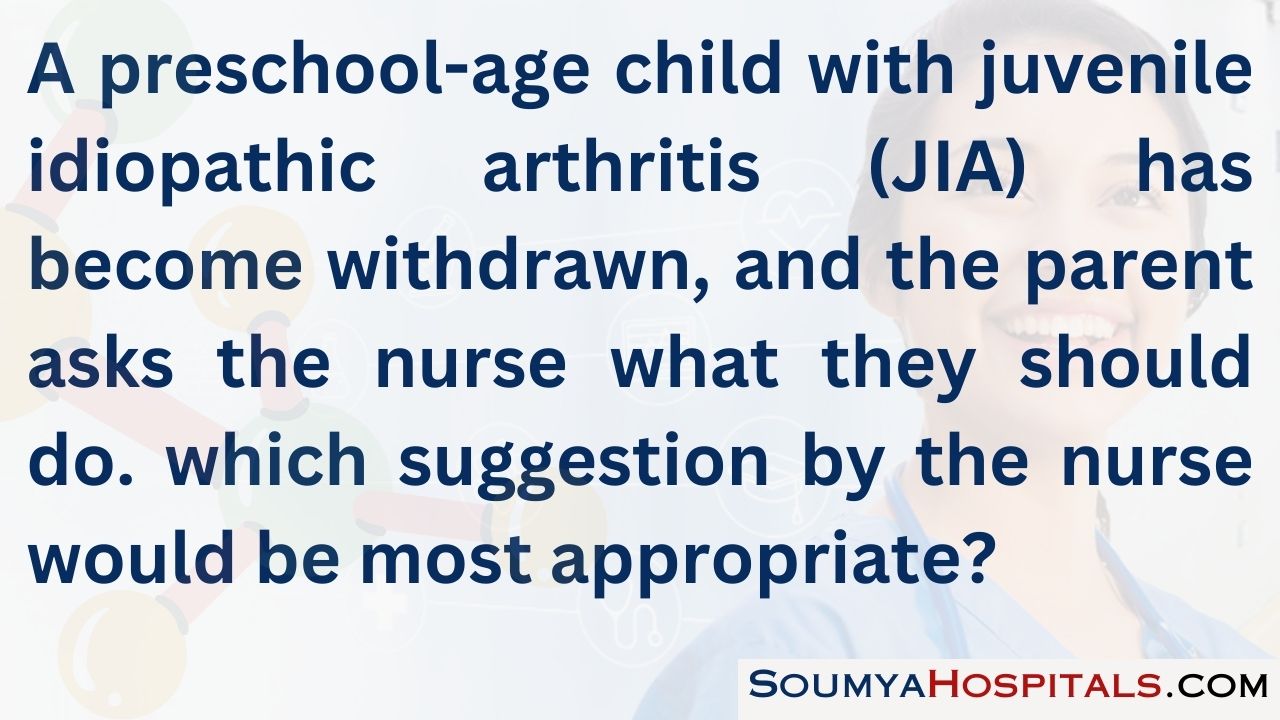
Explanation:
Because the child is dealing with grief and loss associated with a chronic illness, parents need to be supportive and understanding. The child needs to feel valued and worthwhile. Introducing the child to others of the same age who also have JIA most probably would be ineffective because preschoolers are developmentally egocentric.
Although the child needs to feel valued, the mother’s spending more time with the child and less time with her other children is inappropriate because the child with JIA may experience secondary gain from the illness if the family interaction patterns are altered. Also, this action reinforces the child’s withdrawal behavior. Psychological counseling is not needed at this time because the child’s reaction is normal
Question 33.
What information should the nurse include when developing the teaching plan for the parents of a child with juvenile idiopathic arthritis who is being treated with naproxen?
(a) Anti-inflammatory effect will occur in approximately 8 weeks.
(b) Within 24 hours, the child will have anti-inflammatory relief.
(c) The nurse should be called before giving the child any over-the-counter medications.
(d) If a dose is forgotten or missed, that dose is not made up.
Answer:
(c) The nurse should be called before giving the child any over-the-counter medications.
Explanation:
The first group of drugs typically prescribed is the nonsteroidal anti-inflammatory drugs, which include naproxen. Once therapy is started, it takes hours or days for relief from pain to occur. However, it takes 3 to 4 weeks for the anti-inflammatory effects to occur, including a reduction in swelling and less pain with movement. Naproxen is included in only a few over-the-counter medications, but aspirin is in several.
The family should check with the nurse before giving any over-the-counter medications. Toxicity or GI bleeding may occur when nonsteroidal anti-inflammatory drugs are combined. The missed dose will need to be made up to maintain the serum level and to maintain the therapeutic effectiveness of the drug.
Question 34.
A school-age child has 5 lb (2.27 kg) of Buck’s extension traction on his left leg. What finding should the nurse assess the child for? Select all that apply.
(a) dryness of the skin, by removing the foam wraps and boot
(b) alignment of the shoulder, hips, and knees
(c) frayed rope near pulleys
(d) the correct amount of traction weight on the fracture
(e) pressure on the coccyx
Answer:
(b) alignment of the shoulder, hips, and knees
(c) frayed rope near pulleys
(d) the correct amount of traction weight on the fracture
(e) pressure on the coccyx
Explanation:
(b), (c), (d), (e) Buck’s traction provides skin traction that keeps the extremity in straight alignment and can be observed by noting a straight line formed between the shoulder, hips, and knees. The rope must be intact to maintain the prescribed traction from the weights.
The correct amount of traction must be maintained to keep the fractured femur in the correct alignment. Because the client is in a recumbent position, the nurse should also inspect the skin on the back and buttocks for integrity. The nurse should not remove the client’s wraps and boot unless he or she has a health care provider’s (HCP’s) prescription to do so.
Question 35.
A pediatric client has just had a plaster cast placed on his lower left leg. Which action should the nurse take to provide safe cast care?
(a) Petal the cast as soon as it is put on.
(b) Keep the child in the same position for 24 hours until the cast is dry.
(c) Use only the palms of the hand when handling the cast.
(d) Notify the health care provider (HCP) if the client feels heat.
Answer:
(c) Use only the palms of the hand when handling the cast.
Explanation:
The wet plaster cast should be handled using only the palms of the hands to prevent indentations of the cast surface. Petaling a cast should be done only when the edges of the cast are rough and are causing irritation to the client’s skin. The nurse should not keep the child in the same position until the cast is dry.
Doing so would prohibit proper toileting and elimination and would produce undue pressure on the coccyx. The cast typically emits heat as it dries, so notifying a healthcare provider (HCP) is not necessary in this instance. If needed, a fan can be used to circulate the room air.
Question 36.
The nurse is explaining the nature of the fracture to the parents of a school-age client who has a greenstick fracture. Which drawing should the nurse choose to explain the fracture to the parents?
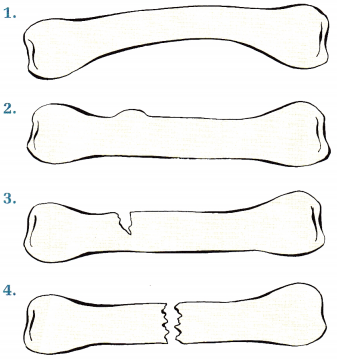
Answer:

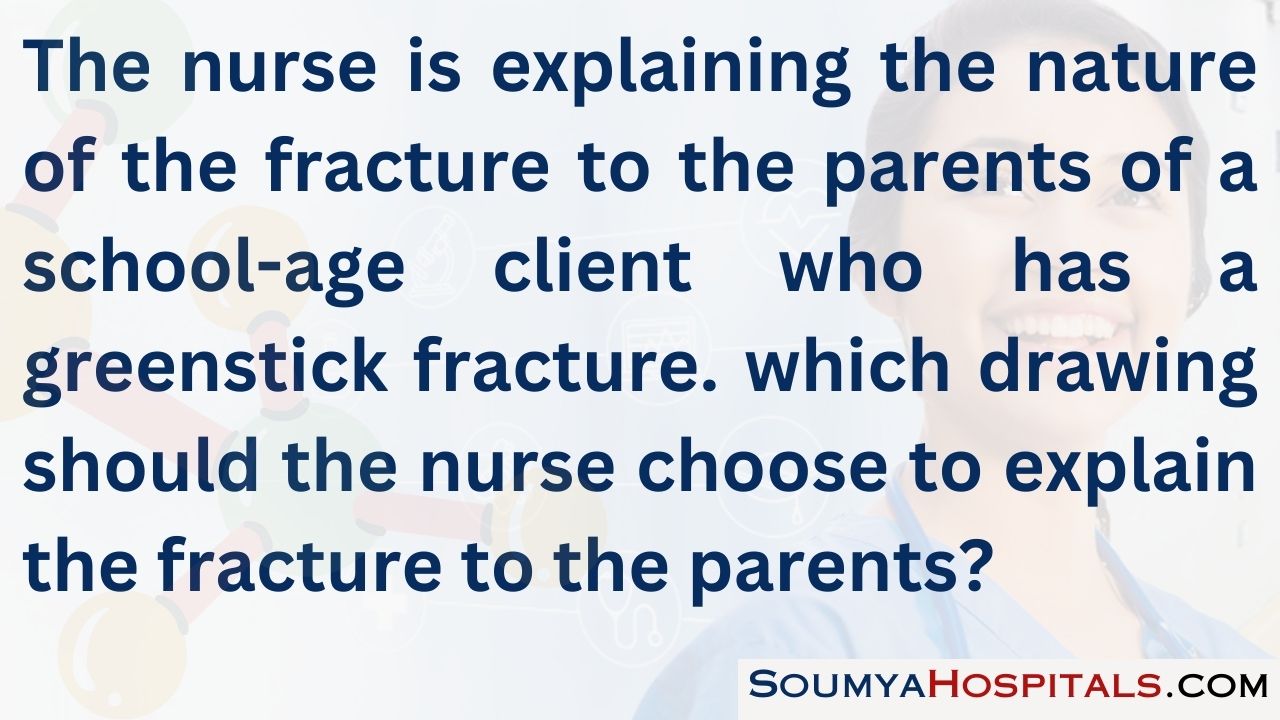
Explanation:
The nurse should show the parents the figure of the greenstick fracture as noted in answer 3 in which the fracture does not completely cross through the bone. Answer A is a plastic deformation or a bend in the bone. Answer B is a buckle. Answer D is a complete fracture.
Question 37.
A pediatric client is given morphine for postoperative pain following a fracture repair. As the nurse is assessing the client for pain 4 hours later, his parent leaves the room, and the child begins to cry. What assessment does the nurse make about the child’s pain?
(a) not in pain because the crying began after the parent leaves
(b) less tolerant of pain because he is upset
(c) in pain because he is crying
(d) not in pain because he was medicated 4 hours ago
Answer:
(b) less tolerant of pain because he is upset
Explanation:
Emotional or physical stress lowers a person’s tolerance of pain. The parent’s presence may have distracted him, and when the parent left, it caused him to focus on the pain he was having. Crying does not automatically indicate pain. The nurse must further assess the client for pain. Although an analgesic was given 4 hours before, pain may be present.
Question 38.
An adolescent client is having surgery to repair a fractured left femur. As a part of the preoperative safety checklist, what should the nurse do?
(a) Ask the teen to point to the surgery site.
(b) Verify that the site, side, and level are marked.
(c) Ask the parents if they have signed the operative permit.
(d) Restate the surgery risks to the parents.
Answer:
(b) Verify that the site, side, and level are marked.
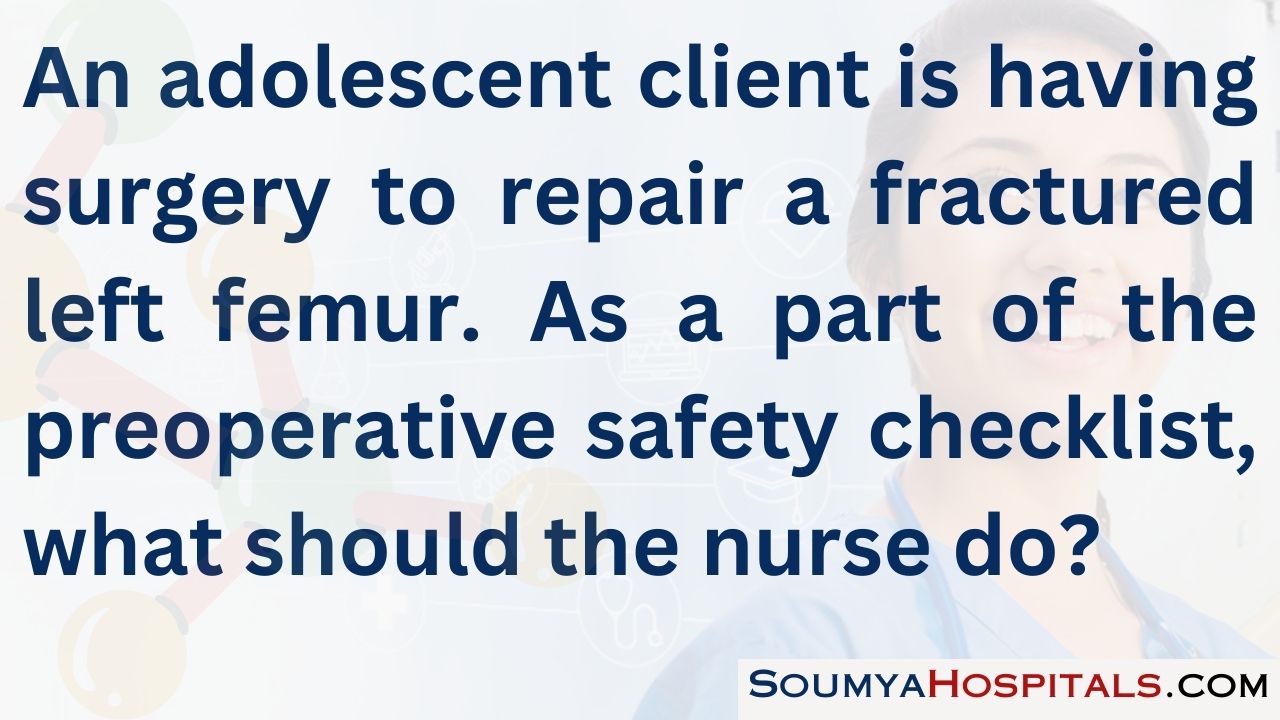
Explanation:
As part of a surgery safety checklist, the nurse must verify that the site, side, and level are marked. Pointing to the area is not sufficient identification of the surgery site. The nurse must verify the form has been signed by reviewing the form. The surgeon holds primary responsibility for explaining the risks of surgery.
Question 39.
A child is admitted with a fracture of the femur and placed in skeletal traction. What should the nurse assess first?
(a) the pull of traction on the pin
(b) the elastic bandage
(c) the pin sites for signs of infection
(d) the dressings for tightness
Answer:
(a) the pull of traction on the pin
Explanation:
Skeletal traction applies the pull directly to the skeletal structure by tongs, pin, or wire. The nurse should assess the pull of the traction on the pin first. This is critical to the success of the traction. Once this is assessed, then the pin sites are assessed for signs of infection. The dressings would be examined after the pull of the traction, neurovascular status, and pin sites were assessed. The elastic wrap is used to anchor skin traction nonadherent straps, not skeletal traction.
Question 40.
The nurse is caring for a child in Bryant’s traction (see figure). What action should the nurse take?
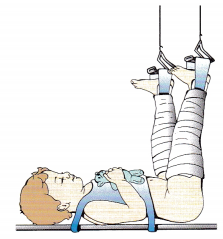
(a) Adjust the weights on the legs until the buttocks rest on the bed.
(b) Provide frequent skin care.
(c) Place a pillow under the buttocks.
(d) Remove the elastic leg wraps every 8 hours for 10 minutes.
Answer:
(b) Provide frequent skin care.
Explanation:
The traction is positioned correctly; the nurse should provide frequent skincare to the back and shoulder areas. The hips and buttocks should be lifted off the bed to provide counter traction; the nurse should not adjust the weights. The nurse should not place a pillow under the buttocks as this would prevent counter traction. The elastic wraps should remain on the legs unless removal is prescribed by the healthcare provider
Question 41.
A preschooler with a fractured femur of the left leg in traction tells the nurse that his leg hurts. It is too early for pain medication. What is the first action the nurse should take?
(a) Place a pillow under the child’s buttocks to provide support.
(b) Remove the weight from the left leg.
(c) Assess the feet for signs of neurovascular impairment.
(d) Reposition the pulleys so the traction is looser.
Answer:
(c) Assess the feet for signs of neurovascular impairment.
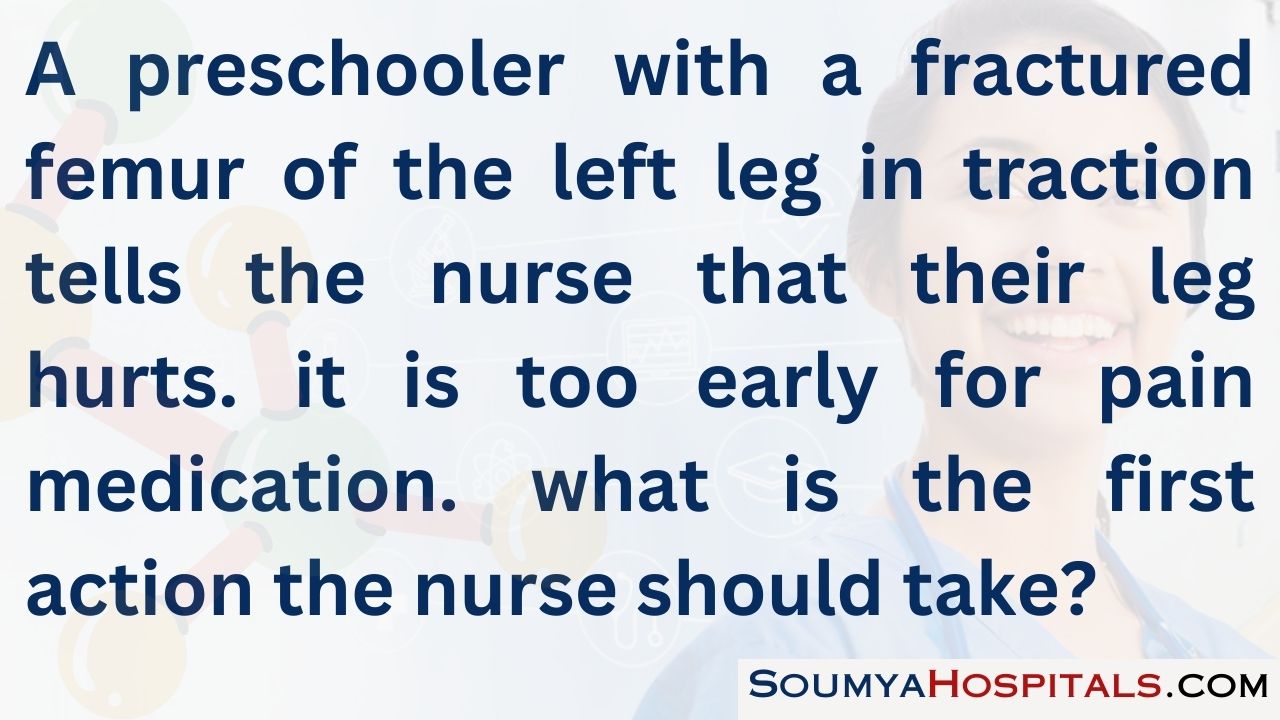
Explanation:
The nurse should assess the client frequently for signs of neurovascular impairment of the feet, such as pallor, coldness, numbness, or tingling. Pillows are not placed under the buttocks because the pillows would alter the alignment of the traction. Weights provide traction and should not be removed. Pulleys help to maintain optimal alignment of the traction and therefore should be left alone.
Question 42.
The nurse in the emergency department is caring for a preschool-age child with a fractured humerus. The child is crying and screaming, “I hate you!” Which action would be most appropriate?
(a) Tell the parents they will need to wait out in the lobby.
(b) Ask the charge nurse to assign this client to another nurse.
(c) Reassure the parents that this is a normal behavior under the circumstances.
(d) Ask the parents to discipline the child so that the team can treat her.
Answer:
(c) Reassure the parents that this is a normal behavior under the circumstances.
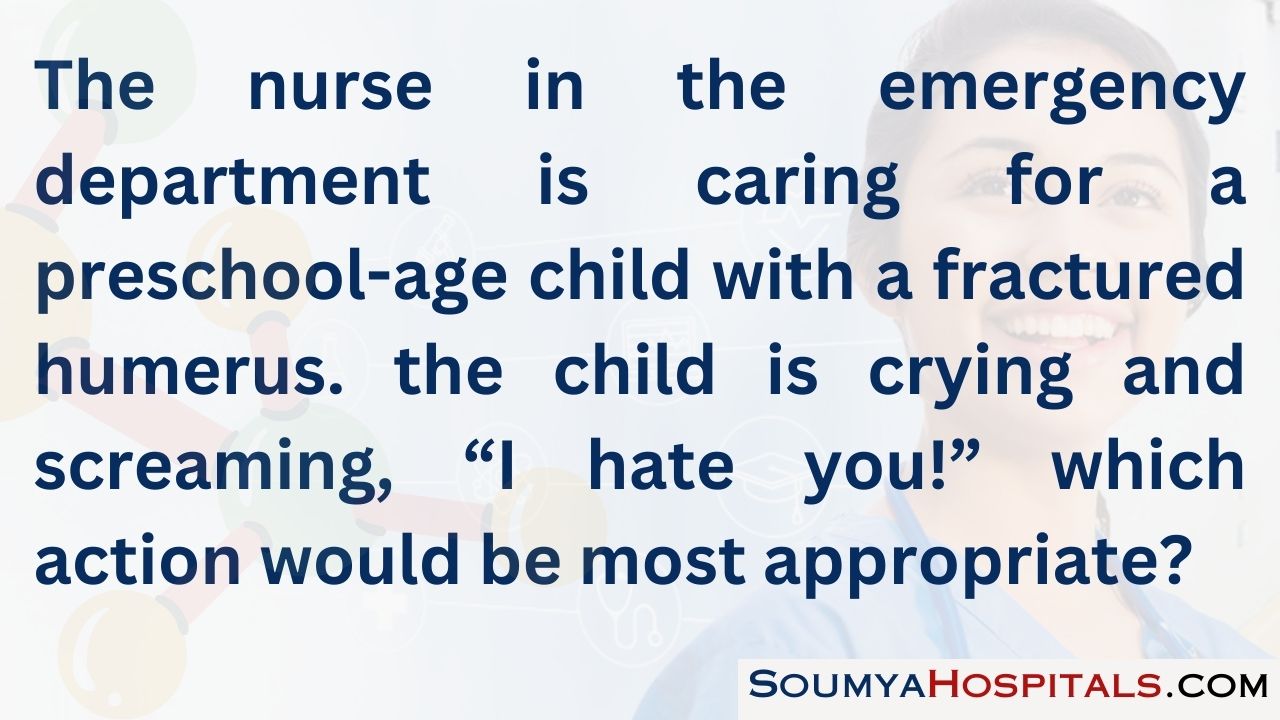
Explanation:
Explaining to the parents that this is a normal reaction under the circumstances is most appropriate. The child’s outburst is related to the child's fear of the unknown. The child is scared and anxious and needs the parents for support. Asking the parents to wait outside would only add to the child’s fear and anxiety. The reaction is normal for a child her age and does not usually call for a change in staff assignments. Asking the parents to discipline their child for her behavior is inappropriate. The nurse needs to handle the situation.
Question 43.
After a plaster cast has been applied to the arm of a child with a fractured right humerus, the nurse completes discharge teaching. The nurse should evaluate the teaching as successful when the mother agrees to seek medical advice if the child experiences which symptom?
(a) inability to extend the fingers on the right hand
(b) vomiting after the cast is applied
(c) coolness and dampness of the cast after 5 hours
(d) fussiness with statements that the cast is heavy
Answer:
(a) inability to extend the fingers on the right hand
Explanation:
Inability to extend the fingers of the involved arm may indicate neurologic impairment caused by pressure on soft tissue. It is not unusual for a child to vomit after experiencing a traumatic injury. It may take up to 72 hours for a plaster cast to dry. Until the cast dries, the dampness causes the sensation of coolness. The cast will seem heavy until the child adjusts to the extra weight. The child may exhibit fussiness (such as whining, crying, or clinging) as a result of numerous causes, such as placement of the cast, the hospital experience, or pain. These reactions are normal and do not warrant medical advice.
Question 44.
The nurse should teach the parent of a child who has a new cast for a fractured radius to do which intervention for the first few days at home.
(a) Use a hair dryer to dry the cast more quickly.
(b) Have the child refrain from strenuous activities.
(c) Watch the child wiggle his fingers once a day.
(d) Administer acetaminophen every 8 to 12 hours for discomfort.
Answer:
(b) Have the child refrain from strenuous activities.
Explanation:
For the first few days after application of a plaster or fiberglass cast, the child should not engage in strenuous activities, to minimize swelling that would cause the cast to become too tight. Use of a hair dryer to complete the drying of the cast is not encouraged because the hair dryer only dries the outside of the cast.
Movement and sensation of the fingers need to be checked several times a day for the first few days. Typically, the parent would be instructed to administer acetaminophen every 4 to 6 hours, not every 8 to 12 hours, for discomfort.
Question 45.
While assessing a 3-year-old child who has had an injury to the leg, has pain, and refuses to walk, the nurse notes that the child’s left thigh is swollen. What should the nurse do next?
(a) Assess the neurologic status of the toes.
(b) Determine the circulatory status of the upper thigh.
(c) Obtain the child’s vital signs.
(d) Notify the health care provider (HCP) immediately.
Answer:
(a) Assess the neurologic status of the toes.
Explanation:
Because the nurse suspects a possible fracture based on the child’s presentation, assessing the neurologic and circulatory status of the toes, the tissues distal to the fracture, is important. Soft tissue contusions, which accompany femur fractures, can result in severe hemorrhage into the tissue and subsequent circulatory and neurologic impairment.
Once this information has been obtained, vital signs can be assessed, and the nurse can notify the health care provider (HCP) and report the findings. In fractures, circulation impairment will occur distal to the injury.
Question 46.
Anticipating that a preschool-age child in traction will have need for diversion, what should the nurse offer the child?
(a) a video game
(b) blocks
(c) hand puppets
(d) remote-controlled car
Answer:
(c) hand puppets
Explanation:
Hand puppets would enable a 3-year- old child in traction to act out feelings within the constraints imposed by the traction. A 3-year-old needs creative play. The video game would make the child too active in bed and does not meet the child’s developmental need for creative play. Blocks would be more appropriate for a younger child. Remote-controlled cars are appropriate for older children but can present a fall risk to others if used in a hospital.
Question 47.
The parents of a child who requires skeletal traction are unable to visit their child for more than 1 hour a day because there are live other children at home and both parents work outside of the home. The nurse recognizes expressions of guilt in both parents. To help alleviate this guilt, the nurse should make which statement?
(a) “I am sure you feel guilty about not being able to visit often.”
(b) “It is important that you visit even for 1 hour.”
(c) “Not all parents can stay all the time.”
(d) “Perhaps you could take turns visiting for a bit longer.”
Answer:
(b) “It is important that you visit even for 1 hour.”
Explanation:
Stressing the importance of the parents’ visiting when they can helps to alleviate the guilt they feel. It allows the parents to feel that they are doing what they can. Acknowledging the guilt gives the parents an opportunity to talk about it but does not help alleviate it. Comparing the parents with other parents does not alleviate guilt feelings. The parents need reinforcement that what they are doing is appropriate. Suggesting that the parents take turns visiting implies that they should feel guilty because they may not be doing all they could.
Question 48.
The child in a new hip spica cast seems to be adjusting to the cast, except that after each meal the child tells the nurse that the cast is too tight. What should the nurse plan to do?
(a) Administer a laxative prior to each meal.
(b) Offer smaller, more frequent meals.
(c) Give the child a mechanical soft diet.
(d) Offer the child more fruits and grains.
Answer:
(b) Offer smaller, more frequent meals.
Explanation:
A hip spica cast encircles the abdomen. When the child eats a large meal, abdominal pressure increases, causing the cast to feel tight. Therefore, the nurse should plan to offer smaller, more frequent meals to minimize abdominal disten-tion. If the child’s appetite were decreased in conjunction with a feeling of fullness, the nurse might suspect that the child was becoming constipated and plan to use laxatives or a higher-fiber diet.
A mechanical soft diet is indicated when the child has difficulty chewing food adequately. Giving the child more fruits and grains would contribute to abdominal distention and problems with the cast tightness after eating.
Question 49.
The nurse is helping a family plan for the discharge of their child who will be going home in a spica cast. Which information would be most important for the nurse to consider?
(a) The bathrooms are all on the second floor.
(b) The child’s bedroom is on the second floor.
(c) A 16-year-old sister will care for the child during the day.
(d) There are three steps up to the front door.
Answer:
(b) The child’s bedroom is on the second floor.
Explanation:
The child with a hip spica cast who is going home and has a bedroom on the second floor of the home needs to have the bed moved to an area that is more central to family life. Negotiating a flight of steps at least twice a day (on awakening in the morning and before going to bed at night) with a child in a hip spica cast would be difficult and most likely dangerous.
Because the child in a hip spica cast will need to use a bedpan or urinal, the bathrooms can be on any floor. Because the family is involved in the discharge, the 16-year-old sister should be taught appropriate care along with the rest of the family. The child can be carried up and down the three steps to the house the few times necessary after discharge.

Question 50.
The nurse is measuring a child for crutches. What factors should the nurse consider? Select all that apply.
(a) type of gait child will be using
(b) degree of child’s elbow flexion
(c) space above the crutch to child’s axilla
(d) weight of the child
(e) whether child has to use the stairs
Answer:
(b) degree of child’s elbow flexion
(c) space above the crutch to child’s axilla
Explanation:
(b), (c) To ensure proper fit of crutches, the child’s elbow flexion should be 20 degrees, and the area above the top of the crutch to the child’s axilla should be 1 to 1.5 inches (2.5 to 3.8 cm). The type of gait, weight of the child, and use of stairs are not factors in the measurement.
Question 51.
During the initial assessment of a child admitted to the pediatric unit with osteomyelitis of the left tibia, when assessing the area over the tibia, which is an expected finding?
(a) diffuse tenderness
(b) decreased pain
(c) increased warmth
(d) localized edema
Answer:
(c) increased warmth
Explanation:
Findings associated with osteomyelitis commonly include pain over the area, increased warmth, localized tenderness, and diffuse swelling over the involved bone. The area over the affected bone is red
Question 52.
A child is to receive IV antibiotics for osteo-myelitis. Before the initial dose of antibiotics can be given, the nurse confirms that a blood sample for which test has been drawn?
(a) creatinine
(b) culture
(c) hemoglobin
(d) white blood count
Answer:
(b) culture
Explanation:
Cultures are used to determine exactly what organism is causing the inflammation. From the culture, sensitivities to various antibiotics may be determined. If the antibiotics are given before obtaining the culture, the antibiotics may inhibit the growth of the organism in the culture medium. This may lead to a delay in the most appropriate treatment.
Unless a child has a known renal problem, baseline creatinine levels are not typically needed. However, levels may be needed during treatment depending on the medication. A complete blood count (CBC) with hemoglobin and white blood cell count is typically prescribed for any suspected infection, but these tests do not identify the causative organism.
Question 53.
A child is being treated with vancomycin 40 mg/kg/day IV divided into three doses for osteomyelitis. The health care provider (HCP) has prescribed drug protocol management by pharmacy and a trough vancomycin level 30 minutes before the third dose scheduled for 0900 hours. The laboratory report returns prior to the third dose:
Laboratory Results:
- 0830 vancomycin 7cmg/mL(4.8mol/L)
- Therapetuic range 10-15 mg/ml (6.9 to 10.4 umol/L)
What action should the nurse take?
(a) Administer the 0900 dose.
(b) Notify the health care provider (HCP).
(c) Notify the pharmacist.
(d) Draw a peak drug level.
Answer:
(c) Notify the pharmacist.
Explanation:
The vancomycin level is not therapeutic and will need to be adjusted. Drug management by the pharmacy is prescribed. Thus, the nurse should notify the pharmacist to adjust the dose. This is very frequently done in institutions with pediatric clinical pharmacists. Giving sub therapeutic doses may prolong care. If needed, the pharmacist would notify the care provider. Peak levels are not prescribed on this client.
Question 54.
The nurse is caring for a child with osteomyelitis who will be receiving high-dose intravenous antibiotic therapy for 3 to 4 weeks. What should the nurse plan to monitor?
(a) blood glucose level
(b) thrombin times
(c) urine glucose level
(d) urine specific gravity
Answer:
(d) urine specific gravity
Explanation:
Long-term, high-dose antibiotic therapy can adversely affect renal, hepatic, and hematopoietic function. Urine specific gravity would provide valuable information about the kidneys’ ability to concentrate or dilute urine, thereby suggesting renal impairment. Blood glucose levels reveal how well the client’s body is using glucose. Thrombin times reveal information about the clotting mechanism. Urine glucose levels reveal information about the body’s use and excretion of glucose.
Question 55.
To meet the developmental needs of an 8-year-old child who is confined to home with osteomyelitis, what goal should the nurse include in the care plan?
(a) Encourage the child to communicate with schoolmates.
(b) Encourage the parents to stay with the child.
(c) Allow siblings to visit freely throughout the day.
(d) Talk to the child about his interests twice daily.
Answer:
(a) Encourage the child to communicate with schoolmates.
Explanation:
Encouraging contact with schoolmates allows the school-age child to maintain and develop socialization with peers, an important developmental task of this age group. Although having family visits and interacting with the child are important, they do not meet the child’s developmental needs. Talking to the child about his interests is important, but encouraging contact with schoolmates is crucial to maintain and develop socialization with peers.
Question 56.
A child with newly diagnosed osteomyelitis has nausea and vomiting. The parent wishes to give the child ginger cookies to help control the nausea. What should the nurse tell the parents?
(a) “You can try them and see how he does.”
(b) “I will need to get a prescription.”
(c) “Your child needs medication for the vomiting.”
(d) “We discourage the use of home remedies in children.”
Answer:
(a) “You can try them and see how he does.”
Explanation:
Some clients find ginger cookies or “snaps” help relieve nausea. Ginger, in small doses such as would be found in the cookies, has few side effects. There is no reason that the parent should not try this dietary intervention; however, the nurse must monitor the client’s response. If the child has a diet as tolerated prescription, there is no need for an addi-tional prescription.
Ultimately, the child may need an antiemetic medication, but dietary strategies are often successful in treating vomiting related to osteomyelitis. Making a universal statement disregarding home remedies is not a client-centered approach.
Question 57.
When assessing an adolescent for scoliosis, what should the nurse ask the client to do?
(a) Bend forward at the waist with arms hanging freely.
(b) Lie flat on the floor and extend the legs straight from the trunk.
(c) Sit in a chair while lifting the feet and legs to a right angle with the trunk.
(d) Stand against a wall while pressing the length of the back against the wall.
Answer:
(a) Bend forward at the waist with arms hanging freely.
Explanation:
Scoliosis, a lateral deviation of the spine, is assessed by having the client bend forward at the waist with arms hanging freely and then looking for lateral curvature of the spine and a rib hump. The other positions will not reveal the deviation of the spine.
Question 58.
The nurse determines that teaching about the correct use of a Boston brace to treat scoliosis has been effective if the child and family state they will remove the brace at which times?
(a) when bathing, for about 1 hour per day
(b) while eating, for a total of 3 hours a day
(c) during school, for about 8 hours a day
(d) when sleeping, for a total of 10 hours a day
Answer:
(a) when bathing, for about 1 hour per day
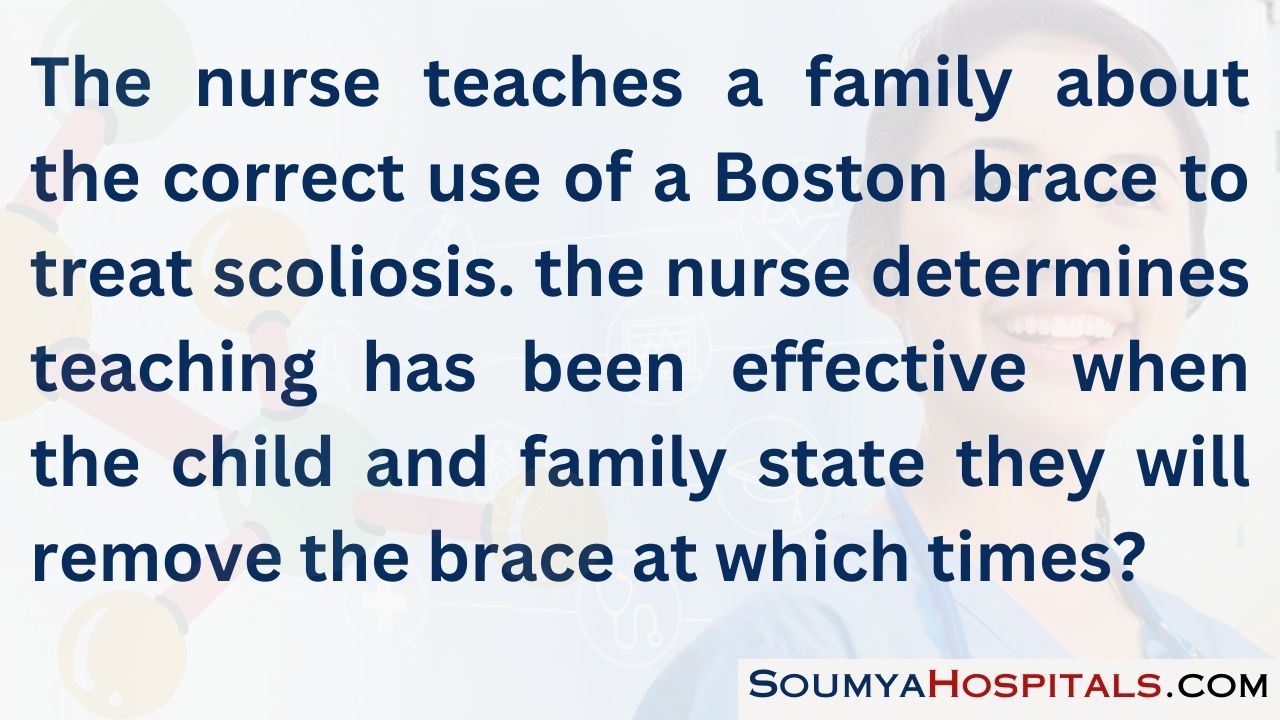
Explanation:
One of the most effective spinal braces for correcting scoliosis, the Boston brace should be worn for at least 16 to 23 hours a day, except when carrying out personal hygiene measures.
Question 59.
When teaching the child with scoliosis being treated with a Boston brace about exercises, the nurse explains that the exercises are performed primarily for what reason?
(a) to decrease back muscle spasms
(b) to improve the brace’s traction effect
(c) to prevent spinal contractures
(d) to strengthen the back and abdominal muscles
Answer:
(d) to strengthen the back and abdominal muscles
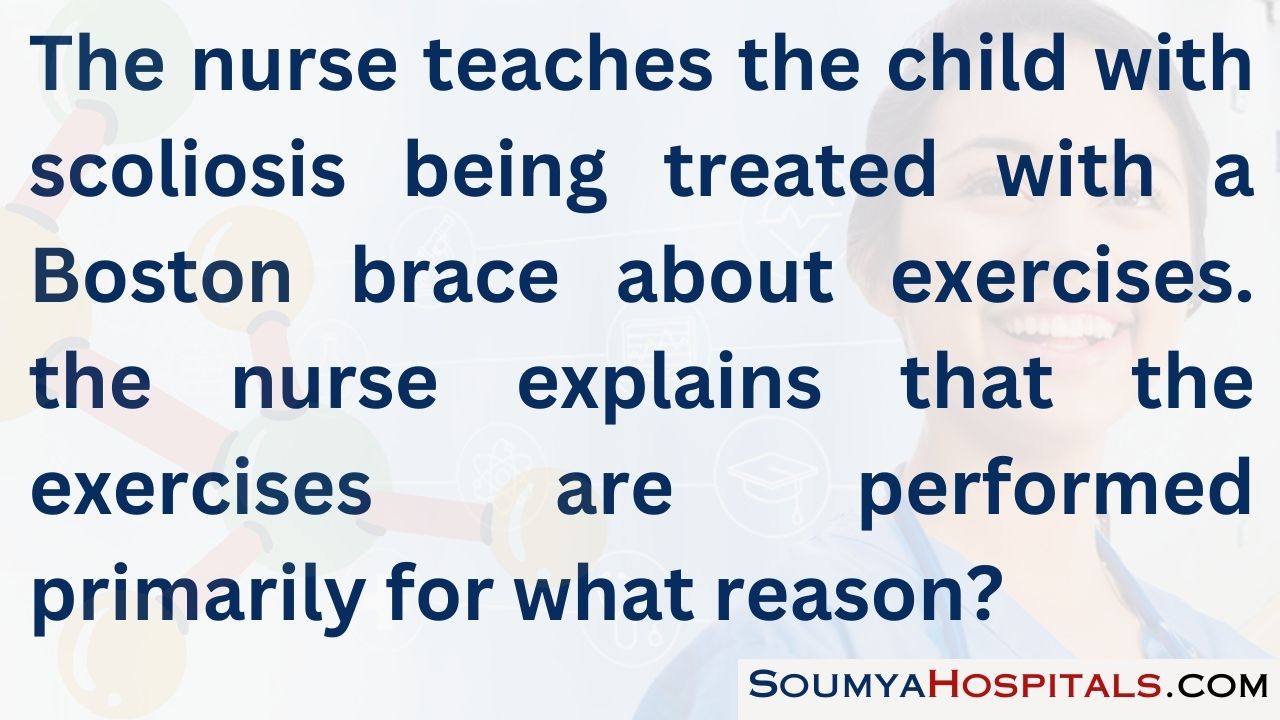
Explanation:
Exercises are prescribed for the child with scoliosis wearing a Boston brace to help strengthen spinal and abdominal muscles and provide support. Typically, children wearing a Boston brace do not have muscle spasms. Performing exercises provides no effect on the brace’s traction ability. Spinal contractures do not occur when a Boston brace is worn.
Question 60.
A pediatric client with scoliosis has to wear a brace. The nurse should develop a teaching plan with the client to include which instruction?
(a) Wear the brace during waking hours.
(b) Use lotions to relieve skin irritations.
(c) Wear a form-fitting t-shirt under the brace.
(d) Bathe the skin under the brace once per week.
Answer:
(c) Wear a form-fitting t-shirt under the brace.
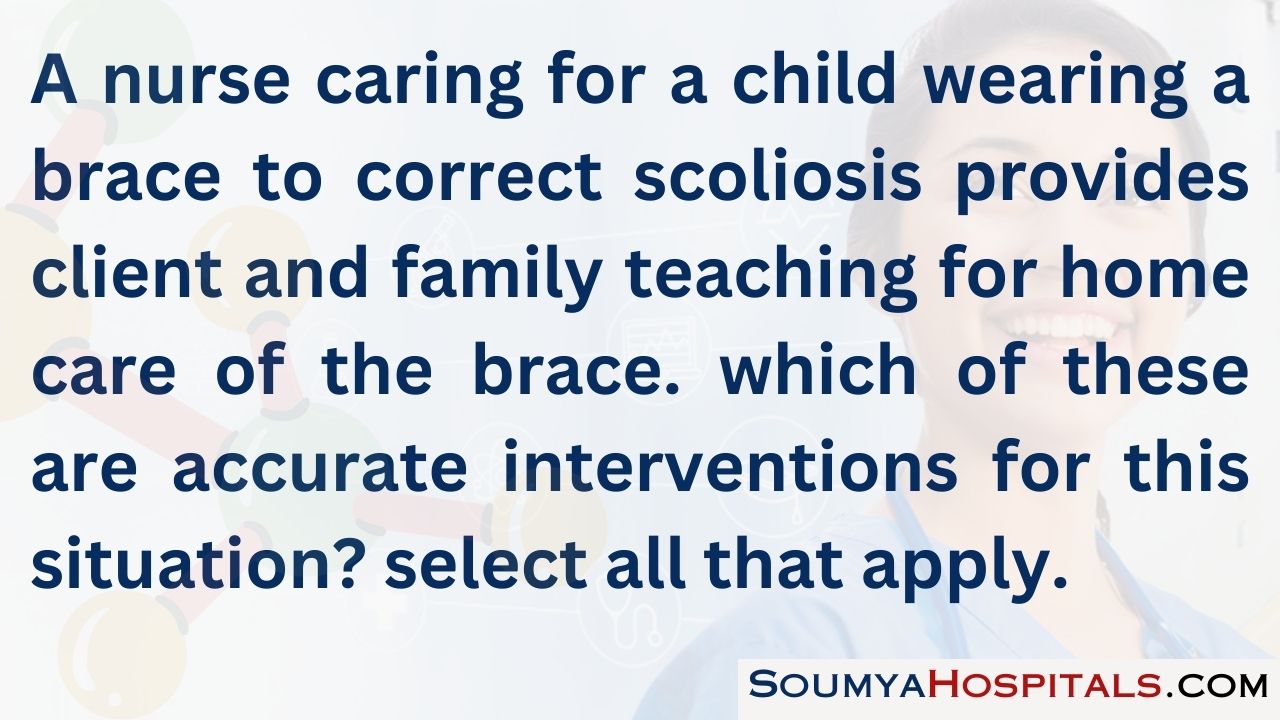
Explanation:
A form-fitting t-shirt can be worn under the brace to prevent skin irritation and collect perspiration. Braces are worn 23 hours each day. Lotions may cause irritation and should not be used. The skin under the brace should be bathed daily to help prevent irritation from the brace. The brace can be removed for bathing so all the skin can be bathed.
Question 61.
A child with spastic cerebral palsy receiving intrathecal baclofen therapy is admitted to the pediatric floor with vomiting and dehydration. The family tells the nurse that they were scheduled to refill the baclofen pump today but had to cancel the appointment when the child became ill. Which action should the nurse take?
(a) Explain that the medication should be discontinued during illness.
(b) Arrange for the pump to be refilled in the hospital.
(c) Reschedule the pump refill for the day of discharge.
(d) Instruct caregivers to call for a refill when the low-volume alarm sounds.
Answer:
(c) Reschedule the pump refill for the day of discharge.
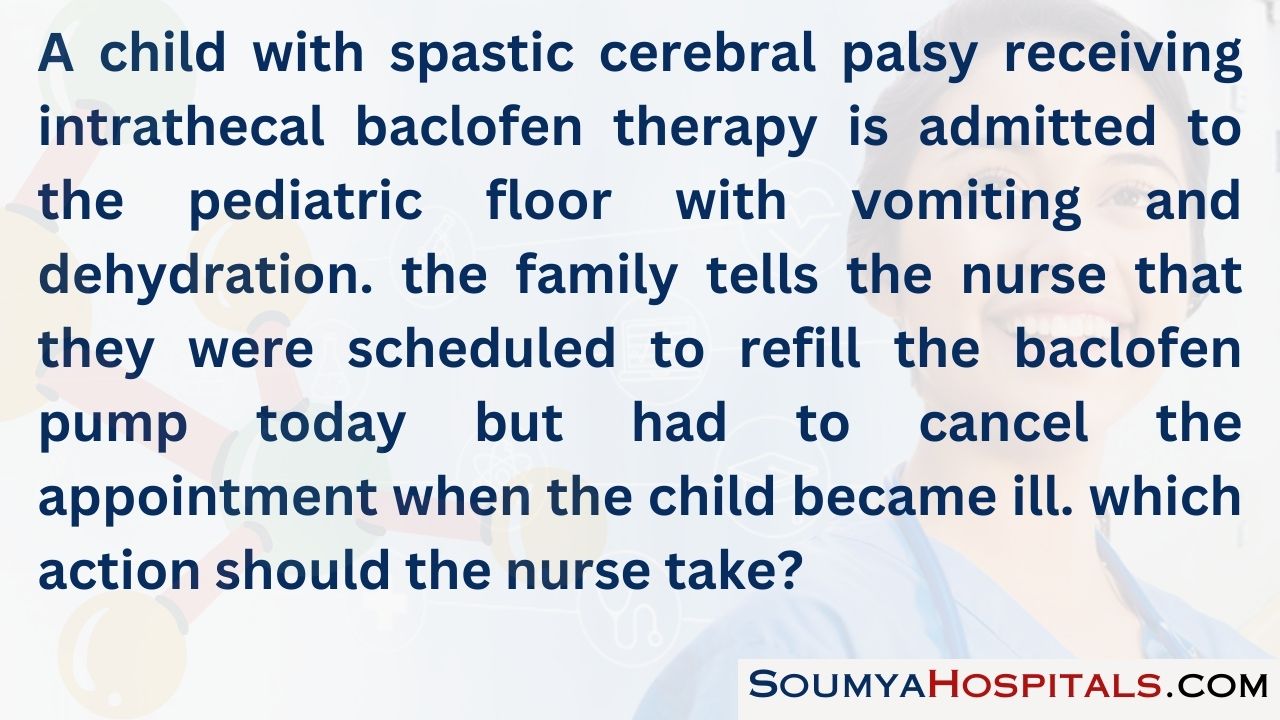
Explanation:
To prevent a baclofen withdrawal, pump refills are scheduled several days before anticipated low-volume alarms. The nurse should make it a high priority to have the pump refilled as soon as possible. Discontinuing baclofen suddenly can result in a high fever, muscle rigidity, change in level of consciousness, and even death.
Waiting until the child leaves the hospital for a refill may lead to a low dose or withdrawal. Waiting for the low-volume alarm puts the client at risk because medication and team members who can refill the pump may not be readily available under all circumstances.
Question 62.
Which procedures can the nurse working on a pediatric floor safely delegate to the licensed practical/vocational nurse (LPN/VN)? Select all that apply.
(a) refilling a baclofen pump
(b) administering gastrostomy tube feedings
(c) inserting hearing aids
(d) giving an IV push medication
(e) calling the morning blood sugars to the healthcare provider (HCP)
Answer:
(b) administering gastrostomy tube feedings
(c) inserting hearing aids
Explanation:
(b), (c) In general, LPN/VNs may perform skills related to feeding, oral medication administration, and activities of daily living, such as the insertion of a hearing aid. Refilling a baclofen pump constitutes administering an intrathecal medication and is beyond the scope of practice for LPNs/VNs in most areas. Some institutions allow LPNs/VNs to give IV push medicines; however, special training is required. Communicating with the health care provider (HCP) would require discussion of the client’s assessments and evaluations, which fall under the RN scope of practice.
Question 63.
A school-age child with juvenile idiopathic arthritis (JIA) is being admitted to the hospital for evaluation of progressively increasing symptoms. The child weighs 60 lb (27 kg) and is 50 inches (127 cm) tall. The nurse reconciles the medications the parent brought from home with the medications prescribed. What should the nurse do? (See chart.)
|
Home meds |
Prescribed meds |
|
1. Ibuprofen tablet 200 mg PO 4 x day (for arthisis) |
Ibuprofen tablet 200 mg PO 4 x day |
|
2. Purchased over the counter Centirizine hydrochloride tablet |
Methotrexate tablet |
|
3. 10 mg PO daily (for allegries) |
10 mg PO every Monday |
|
4. Purchased over the counter |
|
(a) Have the family give the child cetirizine daily using the medication they have from home.
(b) Explain the need to limit over-the-counter medications while in the hospital.
(c) Request a cetirizine prescription from the health care provider (HCP).
(d) Contact the HCP to question the methotrexate.
Answer:
(c) Request a cetirizine prescription from the health care provider (HCP).
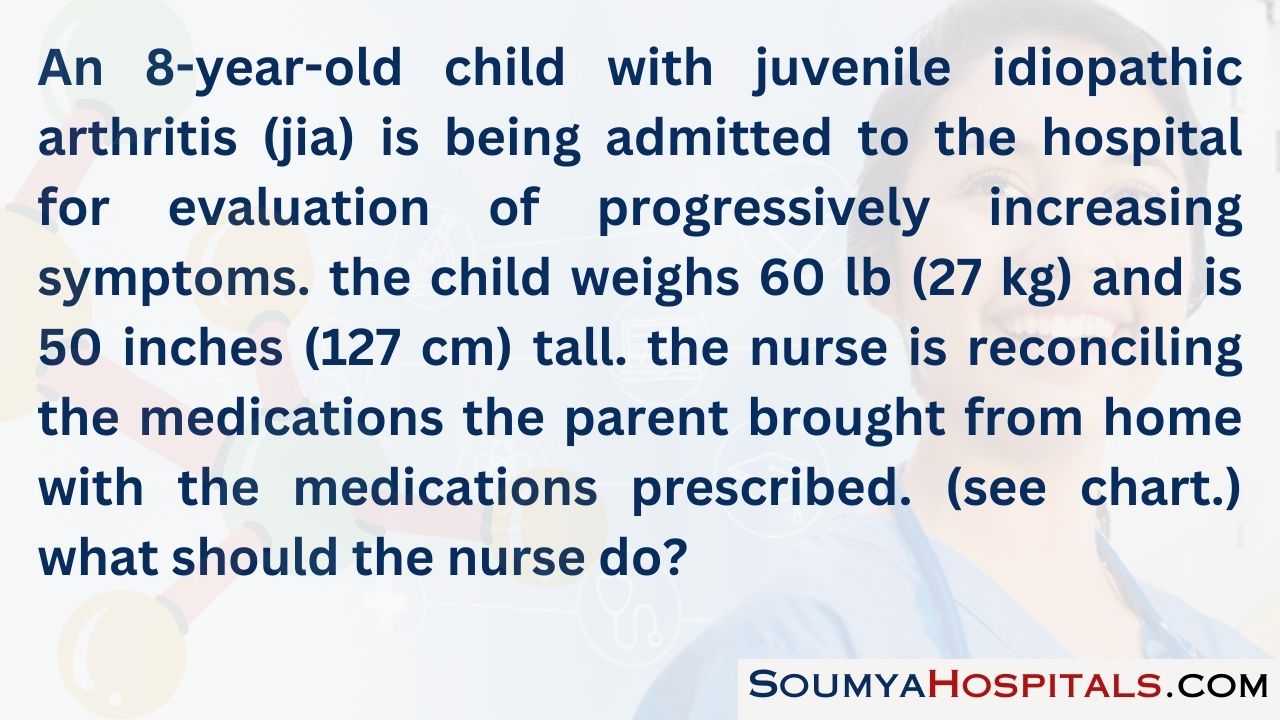
Explanation:
If the child was taking cetirizine for allergies, the nurse should contact the HCP Q for a prescription to continue the medication in the hospital. The provider should either prescribe the medication or provide a valid reason to discontinue its use. Advising the family to take a home supply of medications increases the risk of adverse reactions because the provider would be unaware of potential medication interactions.
Many allergy medications that formerly required a prescription are now available over the counter, and because parents use them, the nurse should be aware of the interactions and risks. The nurse does not need to question the methotrexate prescription as this medication is being added to treat the JIA.
Question 64.
A preschool-age child presents to the emergency department. His father tearfully reports that his son was on his shoulders in the driveway playing when he began to fall. When the child began to fall, the father grabbed him by the leg, swinging him toward the grass to avoid landing on the pavement. As the father swung his son, the child hit his head on the driveway and twisted his right leg. After a complete examination, it is determined that the child has a skull fracture and a spiral fracture of the femur. Which action should the nurse take?
(a) Restrict the father’s visitation.
(b) Notify the police immediately.
(c) Refer the father for parenting classes.
(d) Record the father’s story in the medical record.
Answer:
(d) Record the father’s story in the medical record.
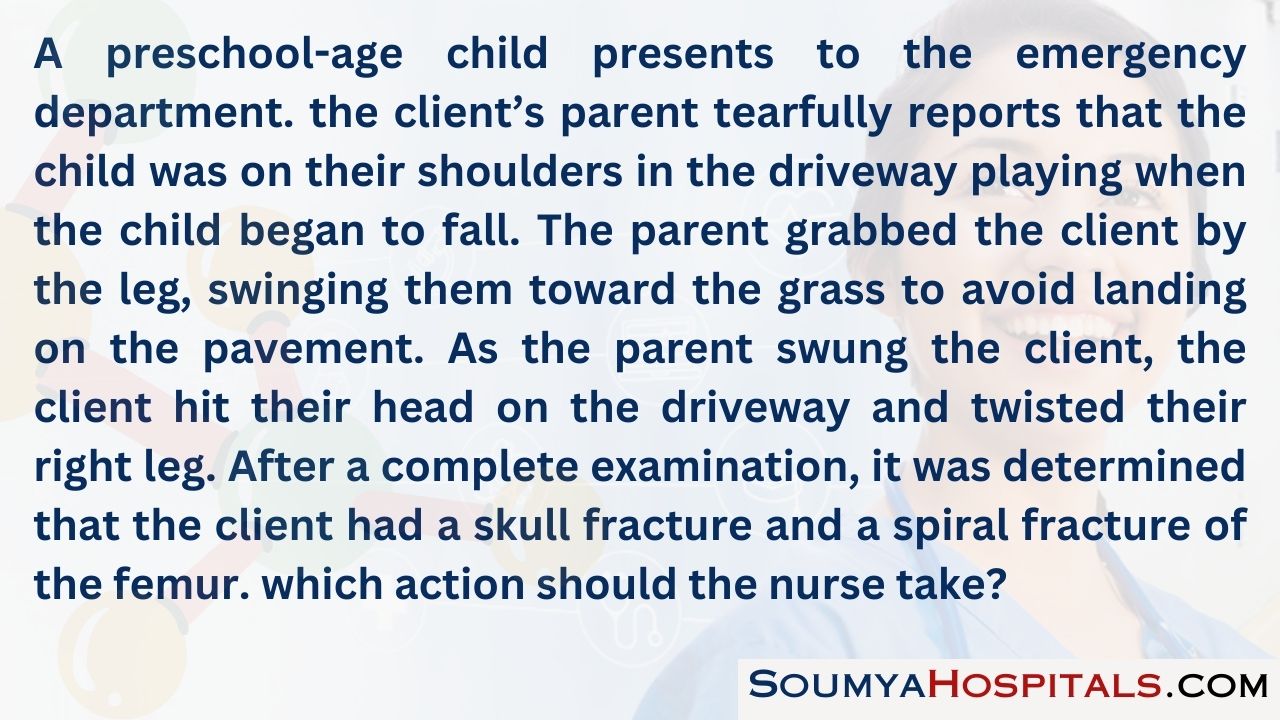
Explanation:
The father’s story is consistent with the injuries incurred by the child; therefore, the nurse should document the cause of the injury. There is no need to restrict the father’s visitation because the injuries sustained by the child are consistent with the explanation given. The police only need to be notified if there is suspicion of child abuse.
The injuries incurred by this child appear to be accidental. There is no need to refer the father for parenting classes. The father appears to be upset about the accident and will not likely repeat such reckless behavior. However, the nurse should educate the father regarding child safety.
Question 65.
An adolescent is brought into the emergency department with a compound fracture. He refuses pain medication stating that his parents are drug addicts and he does not want to become an addict. In what order should the nurse perform the actions from first to last? All options must be used.
(a) Provide the adolescent with educational information on the safe use of pain medications.
(b) Notify the health care provider (HCP) that the adolescent is refusing pain medication.
(c) Allow the adolescent an opportunity to express his concerns about becoming addicted.
(d) Assess the adolescent’s pain using a developmentally appropriate pain scale.
Answer:
(d) Assess the adolescent’s pain using a developmentally appropriate pain scale.
(c) Allow the adolescent an opportunity to express his concerns about becoming addicted.
(a) Provide the adolescent with educational information on the safe use of pain medications.
(b) Notify the health care provider (HCP) that the adolescent is refusing pain medication.
Explanation:
(d), (c), (b), (a) The nurse should assess the adolescent’s pain prior to notifying the HCP. A compound fracture is very painful. The nurse should notify the HCP so they can discuss alternatives and options to treat the pain. Allowing the child an opportunity to express his concerns validates his feelings and concerns. While providing education on the safe use and administration of pain medications may help alleviated the child’s fears, the priority is assessing and treating the fracture.
